Table Of Contents:
|
WHAT IS IT? WHAT IS NEEDED Vehicle Interior Furnishings Equipment WHAT TO EAT WHAT TO DO WHERE TO SLEEP WHAT TO DO TO KEEP COOL WHERE TO MOUNT A HAMMOCK WHERE TO WASH WELCOMED ARE PETS! WARNING ABOUT VANS! WHAT ELSE WOW! WHAT WE ARE ("self-sufficient, intelligent, and brave") |
Low Cost Luxury Living is accomplished most effectively and efficiently by not purchasing
(or insuring or maintaining or paying property taxes on) a house (or condominium) or renting an apartment (or motel room).
Low Cost Luxury Living is accomplished comfortably by fully utilizing what most of us already own, insure, and maintain
and do not have to continuously pay property taxes on or monthly fees for.
That is, our mode of transportation; that is, our vehicle.
Most Long Distance Truck Drivers live in their trucks as the author did while owning and operating a semi as described on the web page at North American Van Lines Owner/Operator Semi Truck Drivers. He has also lived on several Worldwide Oil Exploration ships as described and shown at Kirsten Bravo, Olga Bravo, and Western Horizon and had also lived in several apartments, a 5th Wheel camper, as well as a garage as described and shown at 1969 Camaro SS Restoration.
The author has been a Consulting Software Engineer for many years, as described on his business web site at TDBConsulting.org, and enjoys working on a variety of projects for a variety of companies throughout the country. When working away from home, the author experimented with living in hotels, campgrounds, and was offered to live in company apartments. However, it was quickly learned that the most efficient (close to client company), effective (can be at work in just moments to observe progression of tests running over night), and comfortable (no traffic jams etcetera) is to simply sleep in his comfortable conversion van.
The set of buttons above each image below allow you to Zoom In and Out of the image.
Zooming is most effectively performed by clicking on 'ZOOM IN' or 'ZOOM OUT' and then pressing the enter key repeatedly as desired.
Panning is most effectively performed by using the cursor keys.
Low Cost Luxury Living requires a person who is "self-sufficient, intelligent, and brave",
precisely as the young lady describes at
WHAT WE ARE.
It also requires a reliable, enclosed, and secure vehicle.
The sections below give details about the vehicle, interior, furnishings, and equipment required for Low Cost Luxury Living.
Virtually any reliable, enclosed, and secure vehicle will do for Low Cost Luxury Living.
A conversion van of standard height
(approximately 79 inches, and is 84 inches (i.e. 7 feet) with roof vent protruding 5 inches above roof)
has proven to be excellent and will go anywhere, including inside residential garages and low clearance public parking garages.
As an experiment, a 1984 Buick Regal was lived in for over a month and it too was quite comfortable
after removing the passenger and rear seats and placing half inch plywood on the floor with foam padding on top.
Almost everything is stored in the trunk, which is easily accessed from the passenger compartment with the back of the
back seat removed.
Invest in a reliable and rust free vehicle.
Photographs of the outside of the vehicle follow:
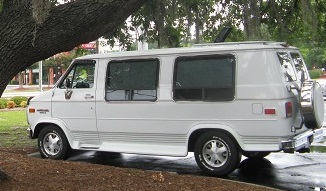
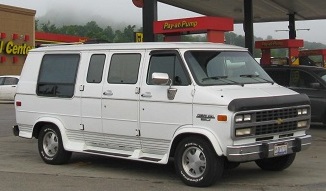
The interiors of some vehicles (e.g. vans) are not finished from the factory and may be finished however the owner desires.
Before beginning, visit lots of Recreational Vehicle Sales showrooms to get ideas of what features are preferred.
It has been shown that there is no need for a sink or stove or oven or refrigerator or anything like that;
nor has there been a need for an electrical or water hook up or anything else.
Constantly keep in mind that any weight added to the vehicle will reduce gas mileage
(i.e. increase fuel consumption and other costs) and increase wear on the driveline
(i.e. engine, transmission, drive shaft, and rear axle assembly), suspension, steering, brakes, and tires.
Heavy items should be mounted as low as possible to keep the vehicle center of gravity as low as possible for maximum stability.
A roof vent with fan is an absolute must to exhaust heat (or fumes) on hellishly hot days.
It is bolted to the roof above the bed and optional bench.
To conserve power for the fan on hot days, park the vehicle in the shade.
Additional windows may be added where desired.
Ensure they are properly installed.
Any electrical wiring may be added as desired.
Ensure it is properly installed.
Note that after the finished walls and carpet are installed, wiring may be inserted along the bottom of walls at the edge of the carpet.
Ensure the wiring is properly protected to prevent short circuits.
Before installing the ceiling and wall coverings, be sure to clean and rust proof the lower portion of the walls well,
especially in the cavities that can be accessed below the floor line.
Then insulate and sound proof well with styrofoam or other type of light weight insulation.
Durable light weight materials, such as as quarter inch oak, birch, or lauan (i.e. Philippine mahogany) plywood,
should be used for covering the walls and ceiling.
The surface may then be finished as desired.
If the vehicle is not equipped with carpet, 3/4 inch styrofoam may be placed on the steel floor to produce an insulated sound
proof flat floor.
Wall to wall carpet is then properly installed.
Clear carpet protector should then be installed over the carpet where required.
To safely secure and store many items, it is convenient to have a securely mounted bed.
An excellent location and size of the bed and optional bench are shown in the graphic below and are set on top
of the wheel wells (shown with dashed lines), which are typically 10 inches high:
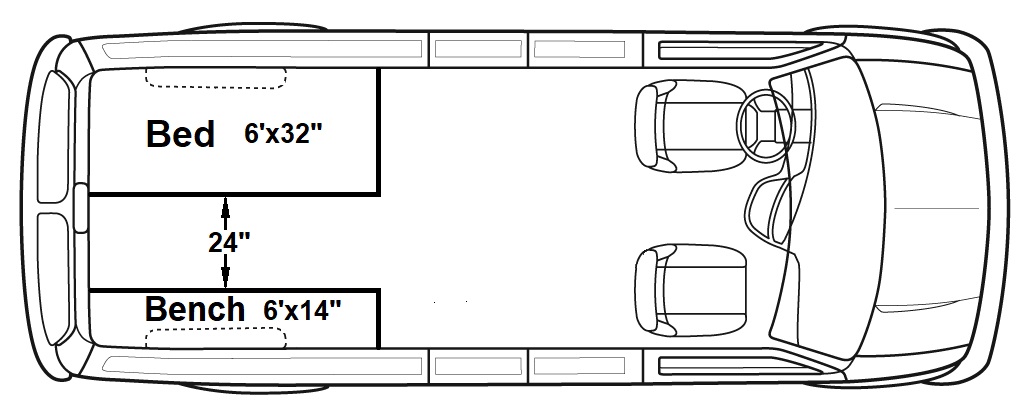
Half inch plywood is used with 2 x 4 inch framing laid flat against the plywood, which is 1.5 inches narrower than the frame
to create a 1.5 inch wide and half inch deep relief along the top long outer edge.
Legs that are the same length as the height of the wheel wells are mounted on all four corners and at the center of the edge
opposite the wheel well.
The bench serves as seating for guests as well as an ottoman for those sitting on the bed.
The open area between the bed and bench allows long and tall items to be loaded from the rear doors.
This includes items such as a 12 foot canoe or kayak or 12 foot lumber and 4 x 8 sheets of plywood stood on the long edge.
The size of the bed can be increased to the entire width of the van by inserting a removable 27 inch wide
section of plywood between the bed and bench, which have the 1.5 inch wide and half inch deep relief along the top long outer
edge.
The top of the rear wheel wells to the floor is approximately 10 inches.
Therefore, the height of the low profile tool box and drawers and large dishpan reserved for changing engine oil, which are
placed under the bed, should be no more than approximately 8 inches high.
If you require or desire the tool box and drawers to be higher, construct the bed and bench accordingly.
Photographs of the interior follow:
The photo below is of the side entrance into the Foyer.
Notice the light weight portable chair and the CD/AM/FM/Weather/MP3 player hanging to the right of the chair.
The privacy sheets hung from bungee straps can be seen to the right and left to easily close off the
front section (right) and/or the rear section (left).
The foil bubble wrap insulation at the foot of the bed (left) encloses the entire rear section during sub-zero weather and
has been proven to be quite comfortable down to 11 degrees below zero (so far) while using only the 1,500 BTU heater.
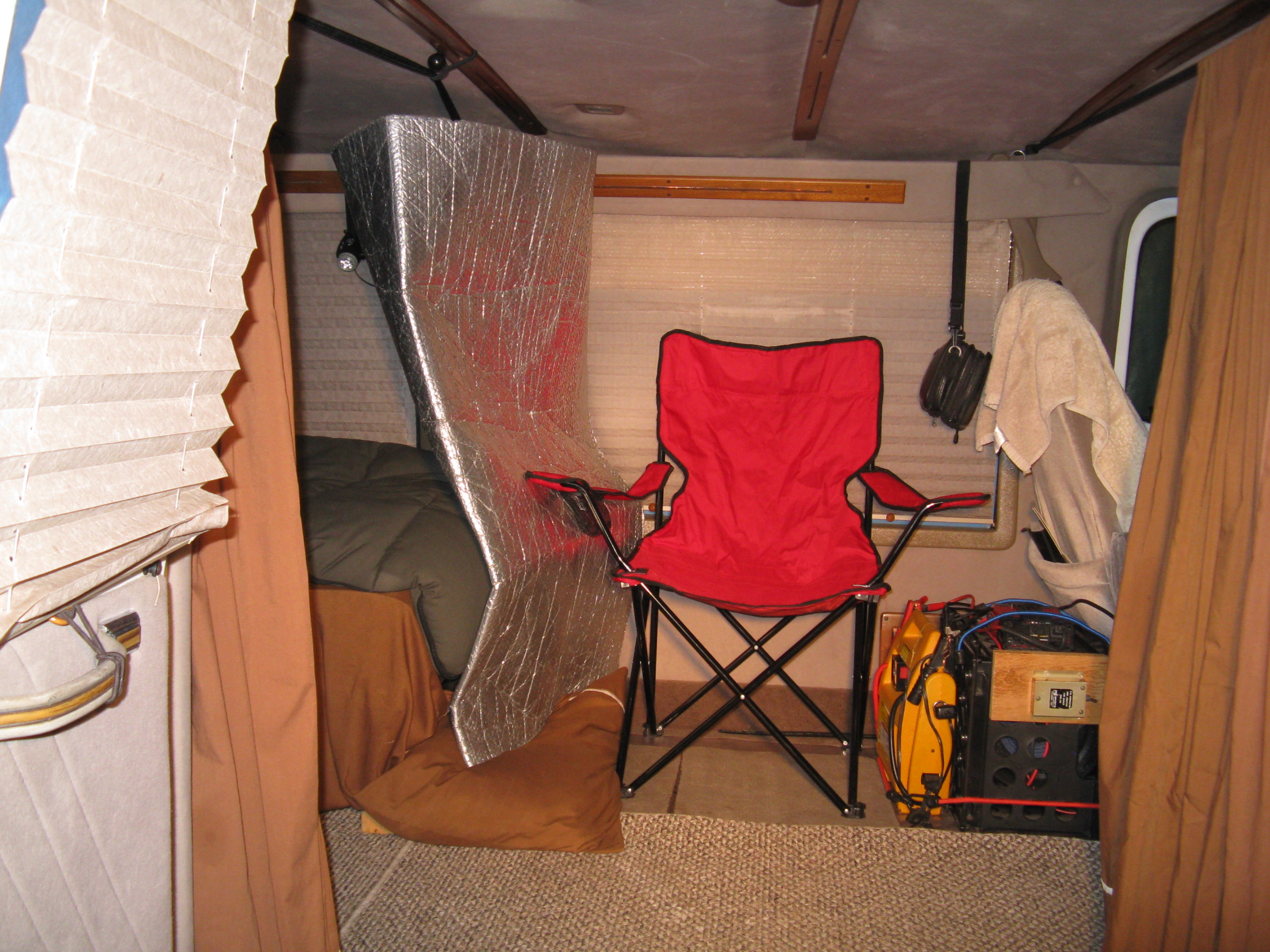
The photo below shows, behind the drivers seat, the 12 VDC Portable Power Pack (yellow) with the 12 VDC to 110 VAC Power Inverter (red) mounted on top of the protective enclosure (black) that the Sub-Woofer of the Stereo (to the right between front seats) is mounted within.
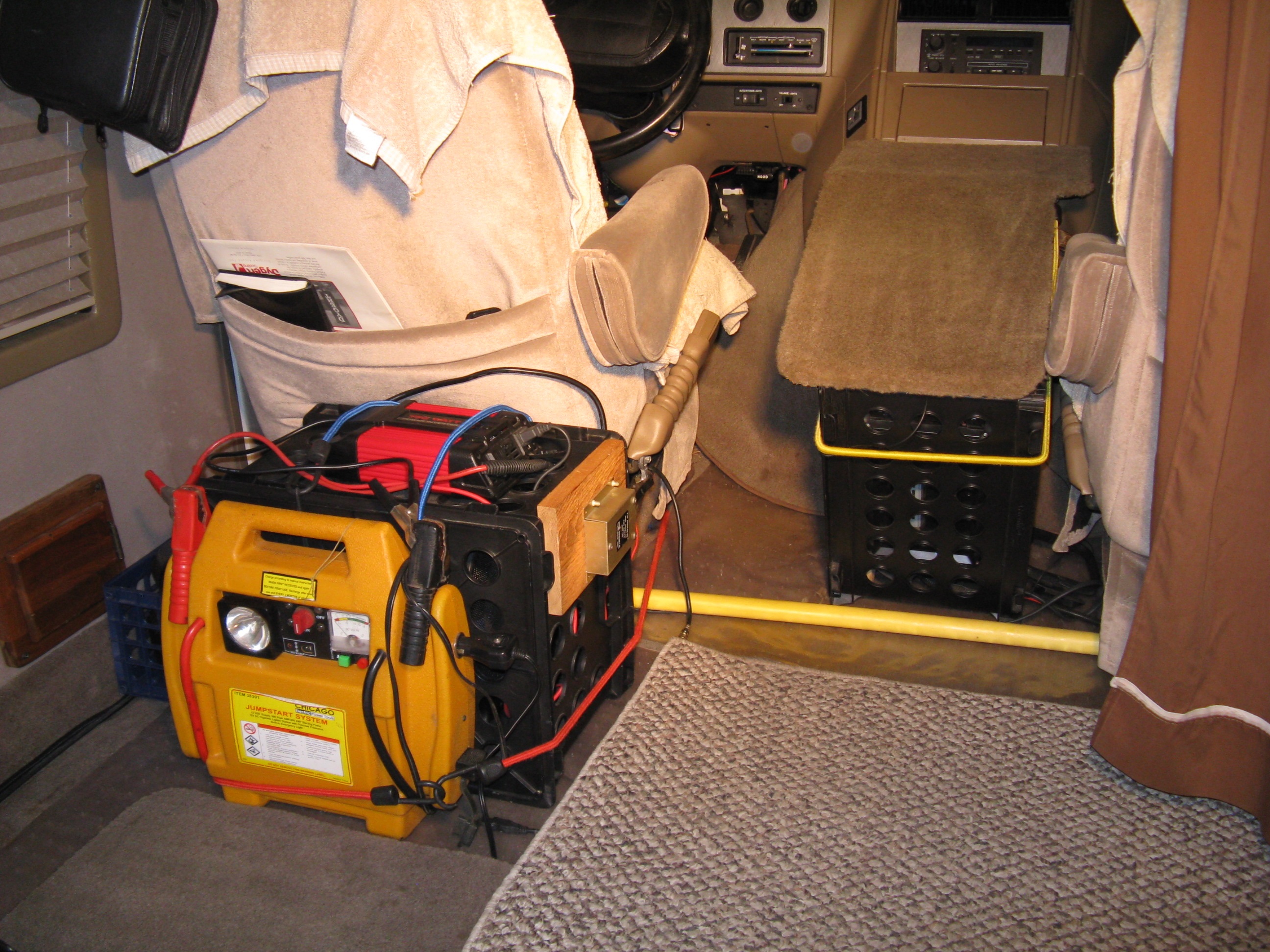
The photo below shows, between the front seats for easy access, the 540 Watt Hi-Fi Stereo mounted within a protective enclosure.
The carpeted cover, that your pet will like to lie down on, over that protective enclosure raises to access the controls.
The left and right speakers are located under the end of the bed and bench facing forward.
Notice too the color coordinated bath towels that effectively preserve and protect the vehicle seats that remain in pristine condition.
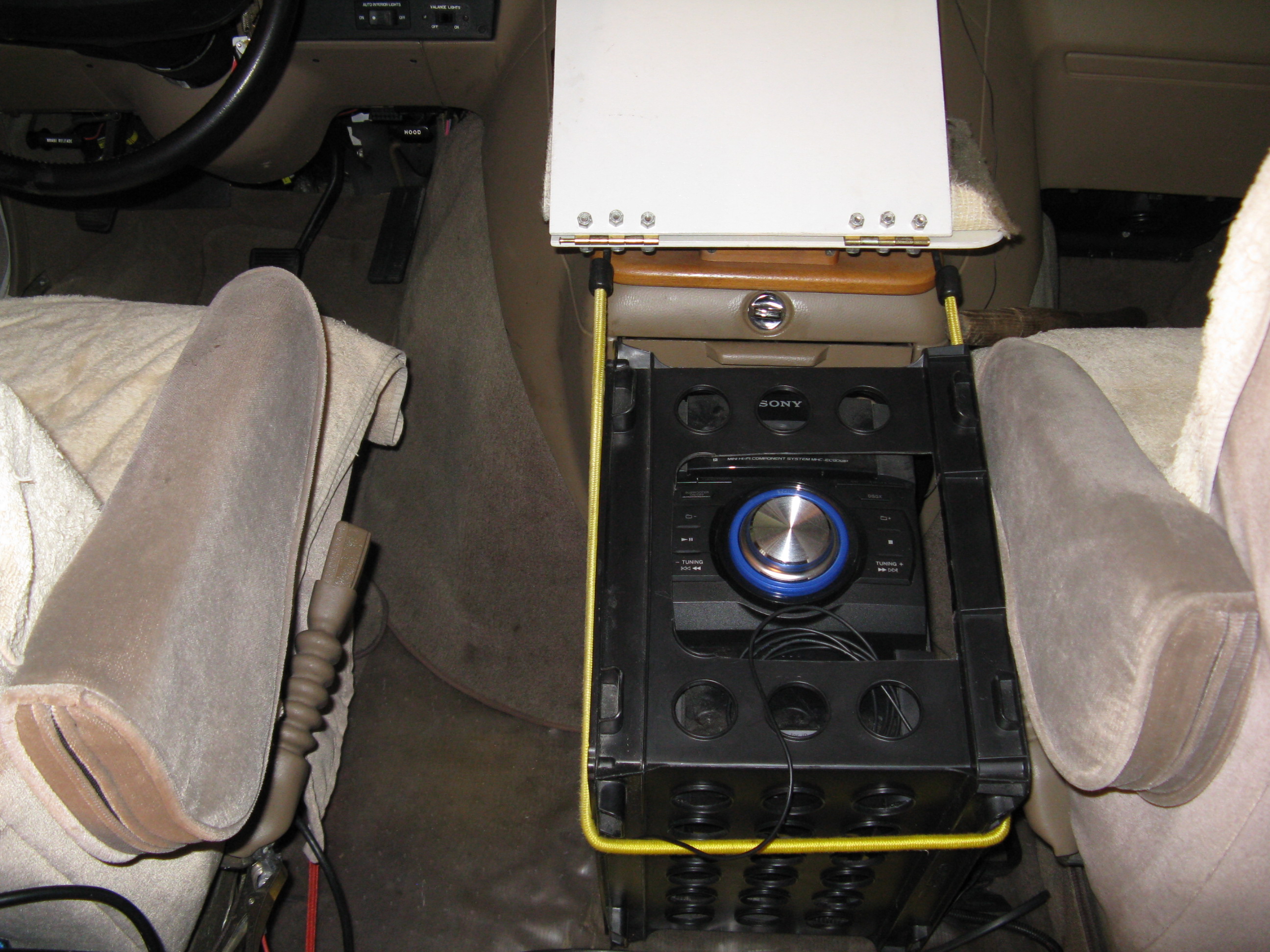
The photo below shows the bed under which are several low profile drawers.
Notice the LED light, seatbelt (to be used when vehicle is being driven),
and foil bubble wrap insulation that covers the entire back wall during sub-zero weather.
Most importantly, notice that the opening of the sleeping bag is towards the heater(s),
which should always be on the floor and away from the bed,
to prevent any portion of the sleeping bag from falling onto a heater when unzipped.
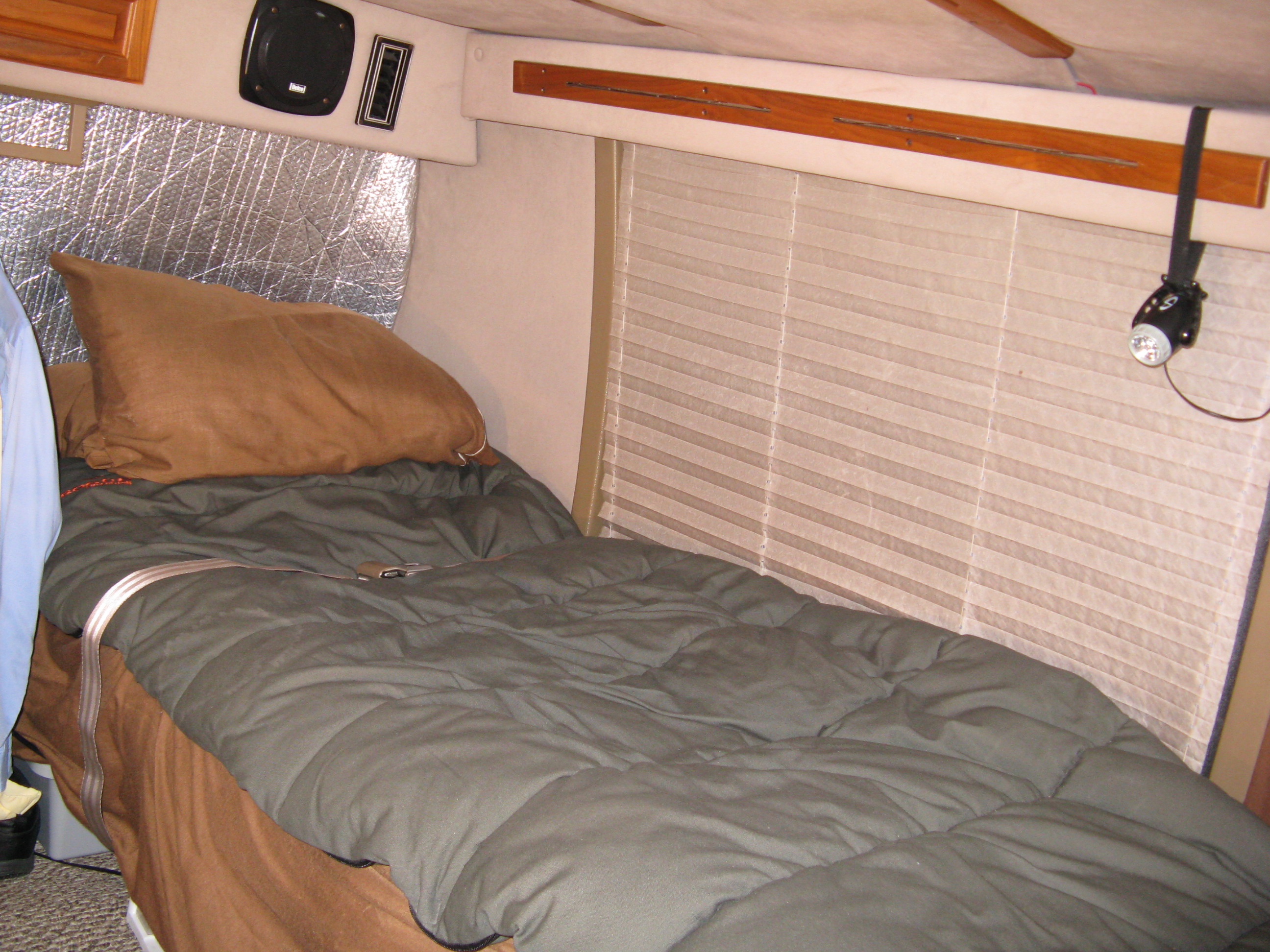
The photo below shows the bench (left) upon which is the computer case, 12 VDC portable TV/DVD, overalls, gloves, and laundry bag.
On the floor is the cooler, 4,000/9,000 BTU heater, 1,500 BTU heater, and tower of drawers upon which is the 12 VDC power strip
to power the TV and LED strip, which illuminates the TV controls, and for charging the cell phone.
The thermometer, jacket, and clothes hanger, behind which is the hook for belts (below which are shoes), can also be seen.
The propane gas line, which can be seen protruding through the foil bubble wrap insulation just above the tower of drawers,
is connected to the 1,500 BTU heater.
Notice too the blue bungee strap that securely and firmly holds the 1,500 BTU heater and portable TV in place.
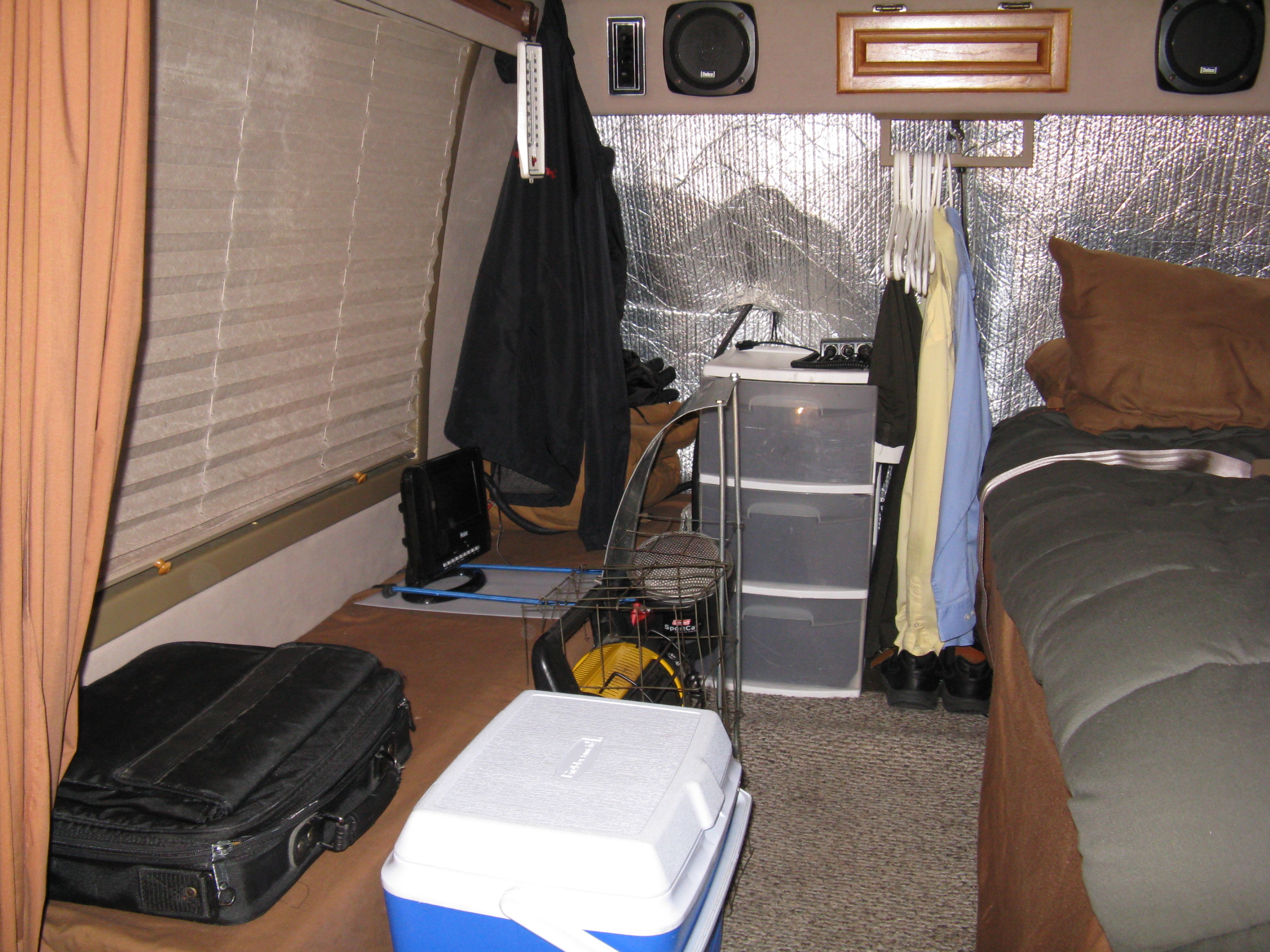
The photo below shows, from the rear section, the foil bubble wrap insulation that encloses the entire rear section.
Notice the roof vent with fan that is an absolute must to exhaust heat or fumes (e.g. cooking, propane, etcetera).
The rubber band is used to help hold two pieces of foil bubble wrap insulation, that are precisely cut to fit in the roof vent,
that have a hole punched into so they can slide over the roof vent handle and be held in place.
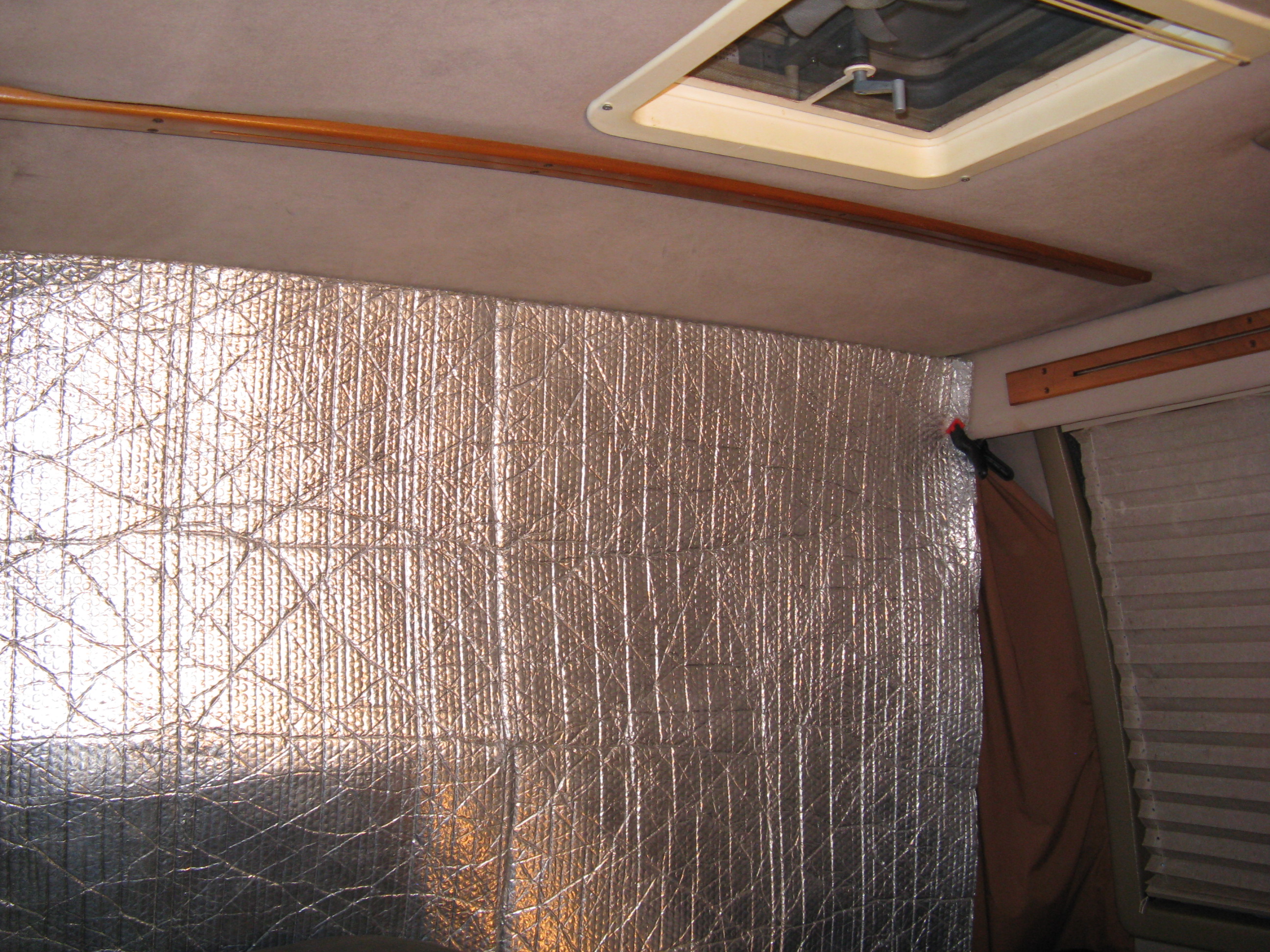
The fine furnishings follow:
-
Foil Bubble Wrap Insulation
This is cut precisely and neatly to fit over the windows tightly.
It serves for privacy and to insulate the vehicle from extreme heat or cold.
Styrofoam fit over that may also be used for additional insulation and sound proofing. -
Color Coordinated Rugs
These are put over the carpet protection and can be easily removed and cleaned by simply shaking.
-
Color Coordinated Bed
Foam padding or air mattress as thick as you personally prefer is used for optimal comfort.
All bedding is color coordinated. -
Color Coordinated Low Profile Drawers
These are used for storing canned goods and other items and are placed under the bed that is held securely in place.
-
Color Coordinated Tower of Drawers
This is placed next to the bed and used for storing folded clothes, towels, swimming trunks, receipts, pens and pencils, stationary, Pepper Spray, Long Sheathed Knife, Flashlight, and other items.
It must be held securely in place. -
Color Coordinated Privacy Sheets
These are hung from the Color Coordinated Bungee Straps to provide privacy.
One is normally hung behind the front seats from ceiling to floor.
Another may be used as a room divider that is hung at the end of the bed and bench from ceiling to floor. -
Color Coordinated Bungee Straps
These are used to hang the Color Coordinated Privacy Sheets and clothes on hangers from and to hold items securely in place.
-
Color Coordinated Thermometer
This is hung from a wall or the ceiling.
-
Color Coordinated Cooler
This is used to hold jugged and bottled water, a can opener, and kitchen utensils along with any fresh fruit and vegetables.
Ice is rarely needed.
It must be held securely in place while driving. -
Color Coordinated Aluminum Lawn Chairs
For indoor and outdoor use and must be held securely in place while driving.
-
Color Coordinated Bath Towels
These serve not only as bath towels, but also to preserve and protect and color coordinate the factory vehicle seats and for turning aluminum lawn chairs into light weight color coordinated furniture.
-
Color Coordinated Laundry Bag
This is simply a color coordinated pillow case to hold laundry that needs to be washed.
It may be placed wherever is convenient.
Equipment
The equipment required follows. PLEASE read, understand, and follow all safety instructions!
-
12 VDC Portable Power Pack
That shown below (yellow) will work well:
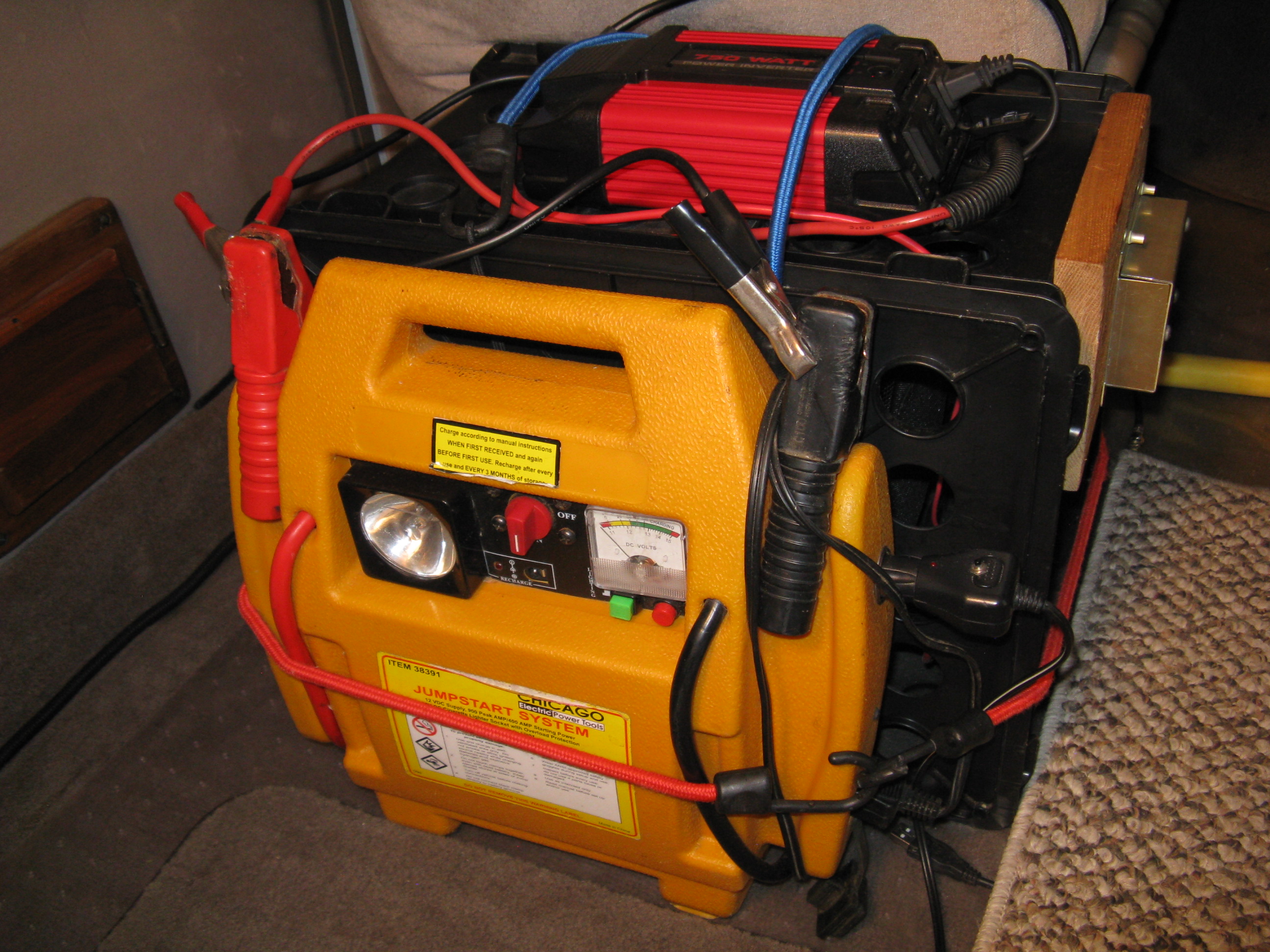
This must be securely held in place and is placed in an easily accessable location to access when needing to jump start a vehicle or to have power wherever you like.
-
Electrical Switch
An Electrical Switch, such as that shown below (enclosed in a Foster Airdata Systems enclosure), is used to connect (switch up) and disconnect (switch down) the 12 VDC Portable Power Pack (left) to and from the vehicle battery.
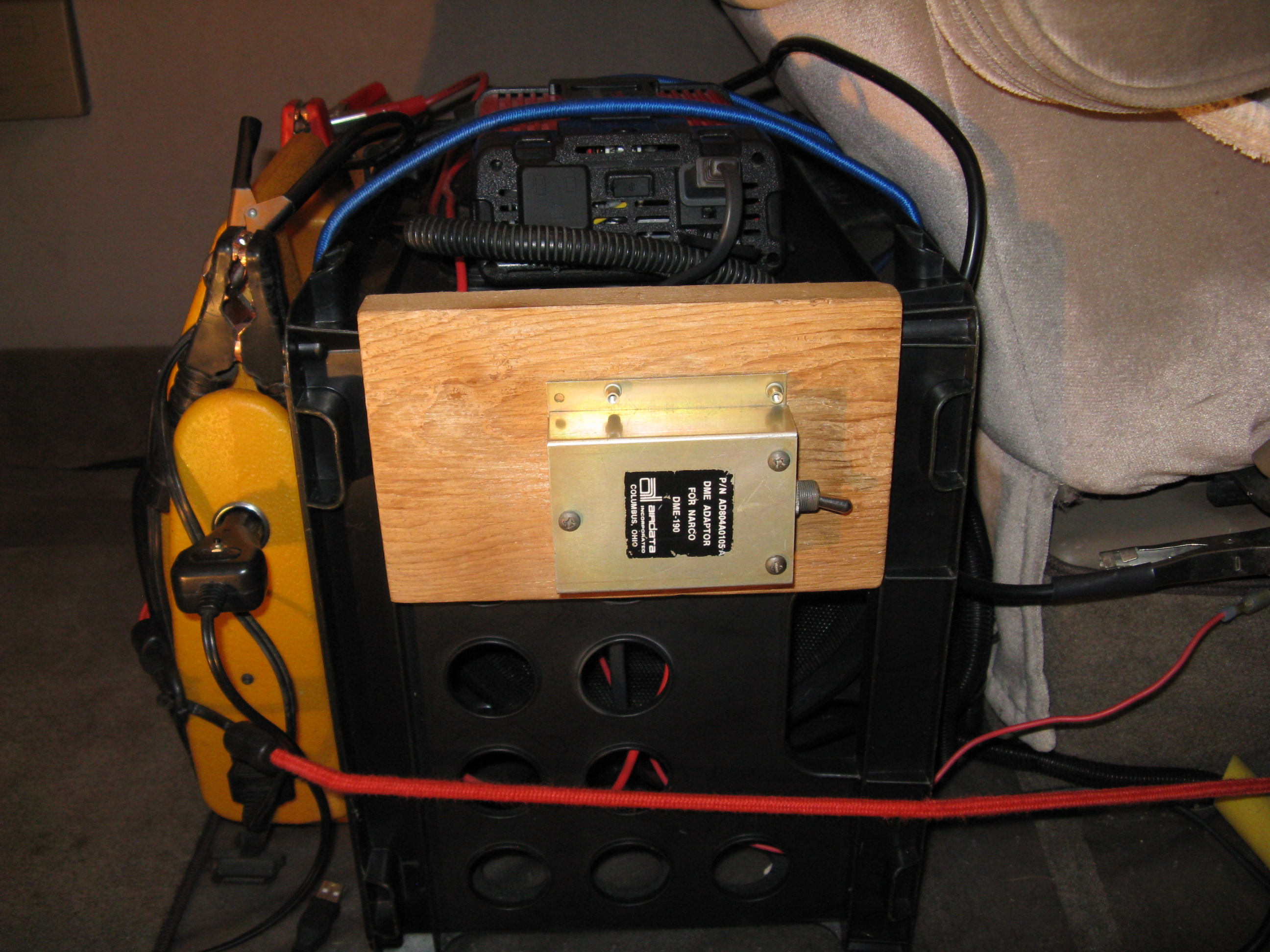
It is very important to not let the vehicle battery fully discharge because that reduces battery life considerably.
While driving, make sure the Portable Power Pack is connected to the vehicle power and is being charged.
When lighting is needed when parked, a small 12 VDC LED light, connected to the Portable Power Pack and hung from the ceiling, is only turned on when needed.
When powering the LED light, disconnect the Portable Power Pack from the vehicle power to prevent the possibility of the vehicle battery from discharging. -
12 VDC to 110 VAC Power Inverter
The Power Inverter is rarely used because it is normally nicer to use the 110 VAC power at the library with all of it's amenities, such as a fireplace or air conditioning.
This must be securely held in place.
The 750 Watt one shown below (red) will work well:
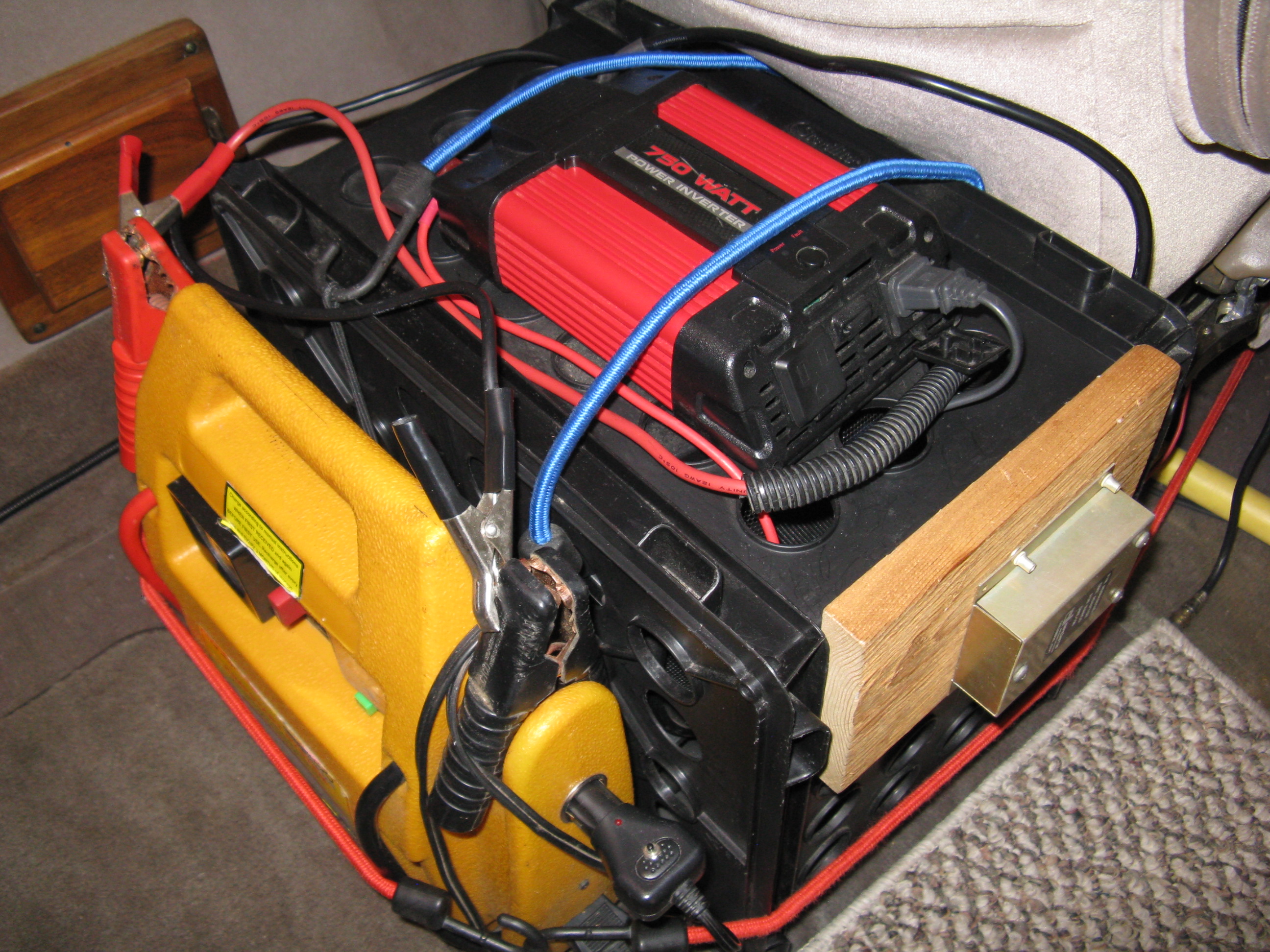
-
Portable Propane Heaters
A Portable Propane Heater of 1,500 BTUs and another of 4,000 and 9,000 BTUs will work well.
For temperatures down to freezing (i.e. 32 degrees), the 1,500 BTU heater alone has been adequate.
During sub-zero temperatures (e.g. 11 degrees below zero so far), the 4,000 BTU heater setting alone has been adequate.The photos below are of Coleman SportCat 1,500 BTU heaters for which one serves as a spare.
The photo to the left shows one as provided by Coleman.
The photo to the right shows one mounted inside a heat deflector that was designed and built by the author for additional safety and to allow items to be placed above the heater for warming and drying and for cooking. The heater handle is bolted to the back panel of deflector and a strap is strapped from the bench, around the deflector back panel, through the heater handle, and back to the bench.
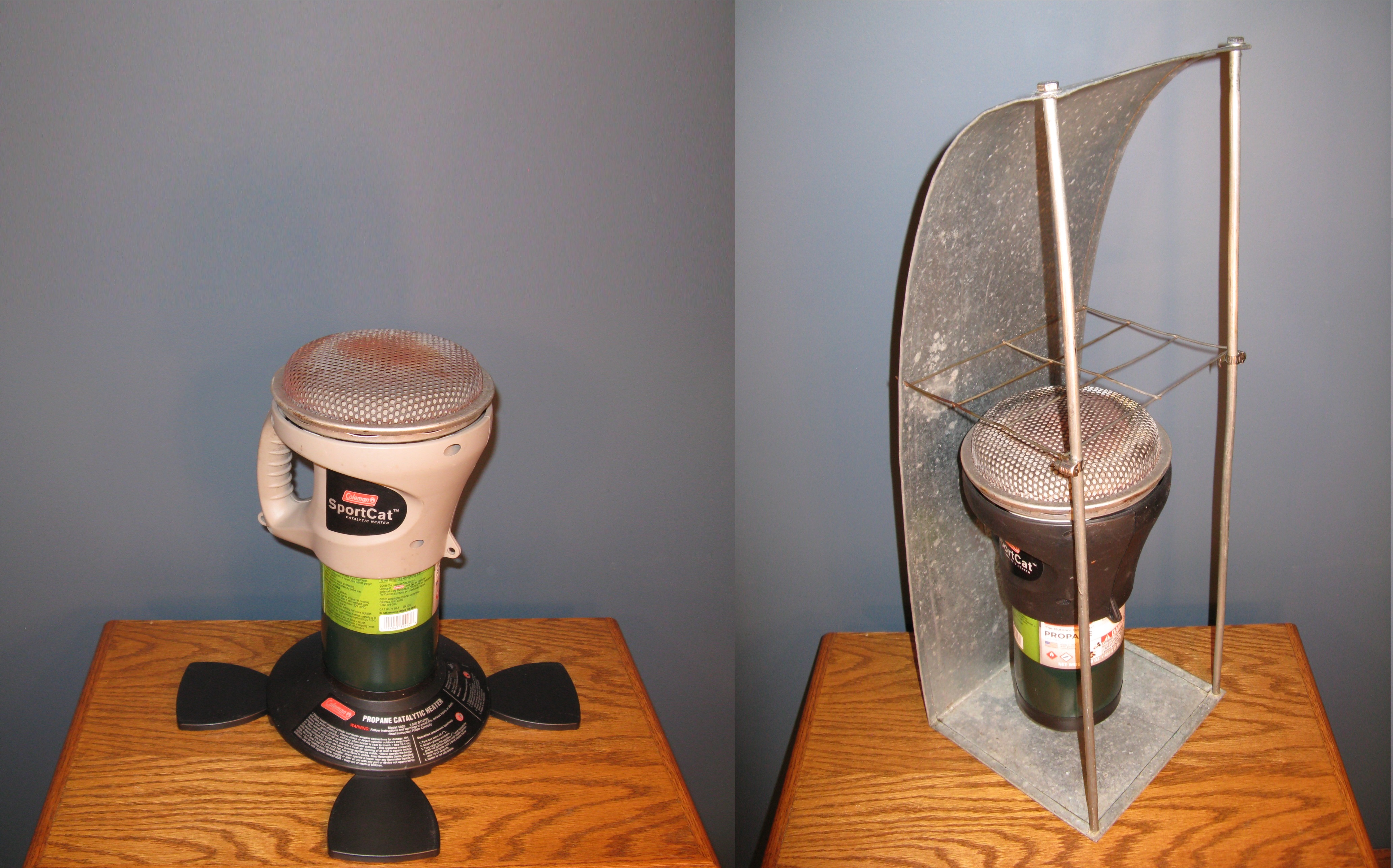
The photos below are of a Mr. Heater heater that includes a pilot light spark ignition, 4,000 BTU and 9,000 BTU settings, and low oxygen, pilot light out, and tip over automatic shut off systems.
The photo to the left shows the heater as provided by Mr. Heater.
The photo to the right shows the heater with a safety cage that was designed and built by the author for additional safety and to allow items to be placed above the heater for warming and drying.
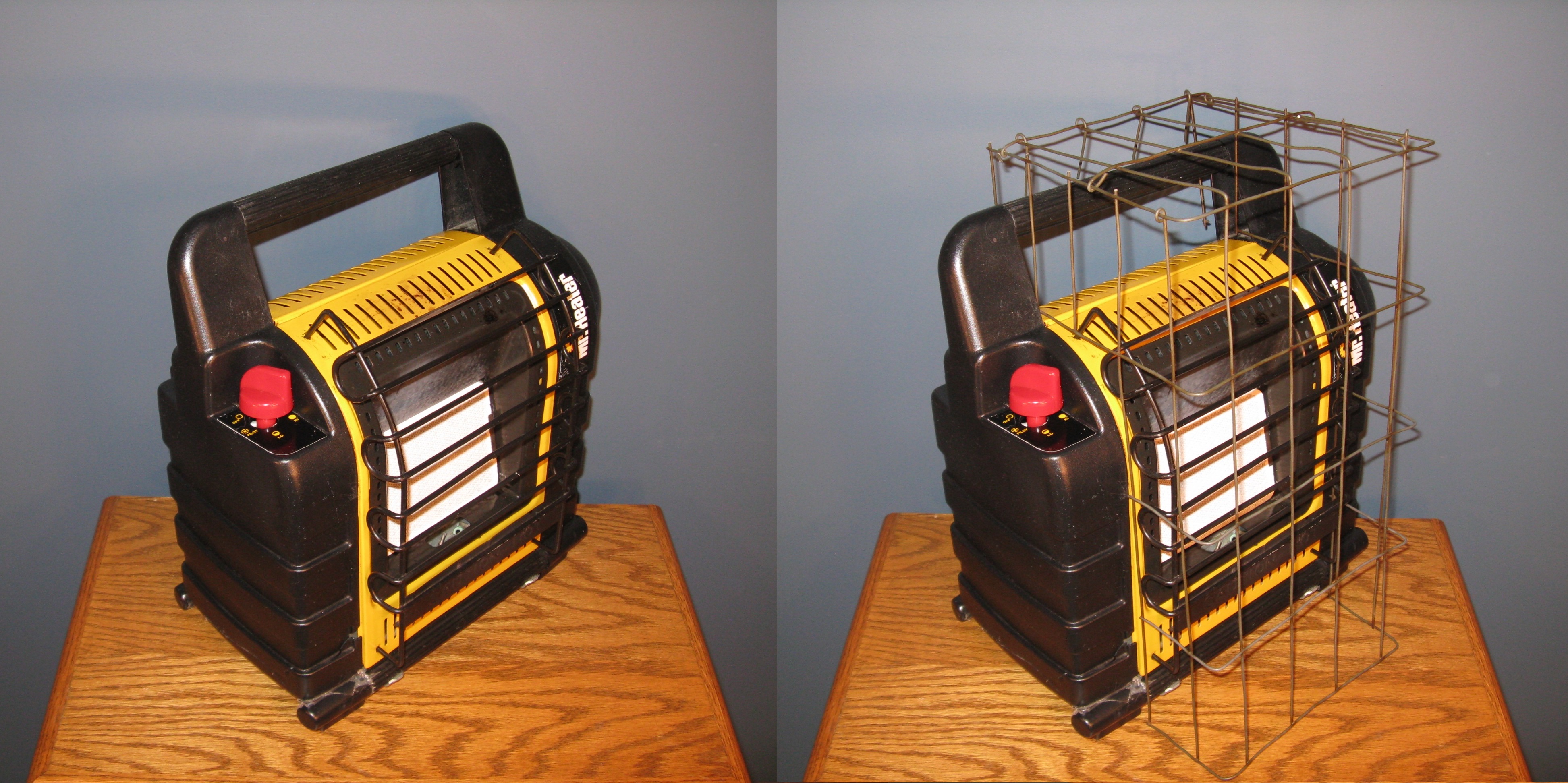
As shown in the photo below, a propane tank may be mounted to the back of the vehicle with the propane line connected to the tank, extending through the rear window, and connected to either the 1,500 BTU or 4,000/9,000 BTU heater.
Note that a stainless steel chain and 2 rubber straps are used to hold the tank securely in place to the rear door handle and to the spare tire mounting bracket.
During winter, you will need to have the tank refilled, or purchase a "Propane Exchange", about once a month.
A "Propane Exchange" may be purchased at Walmart, The Dollar Store, or at many gas stations for about $20.
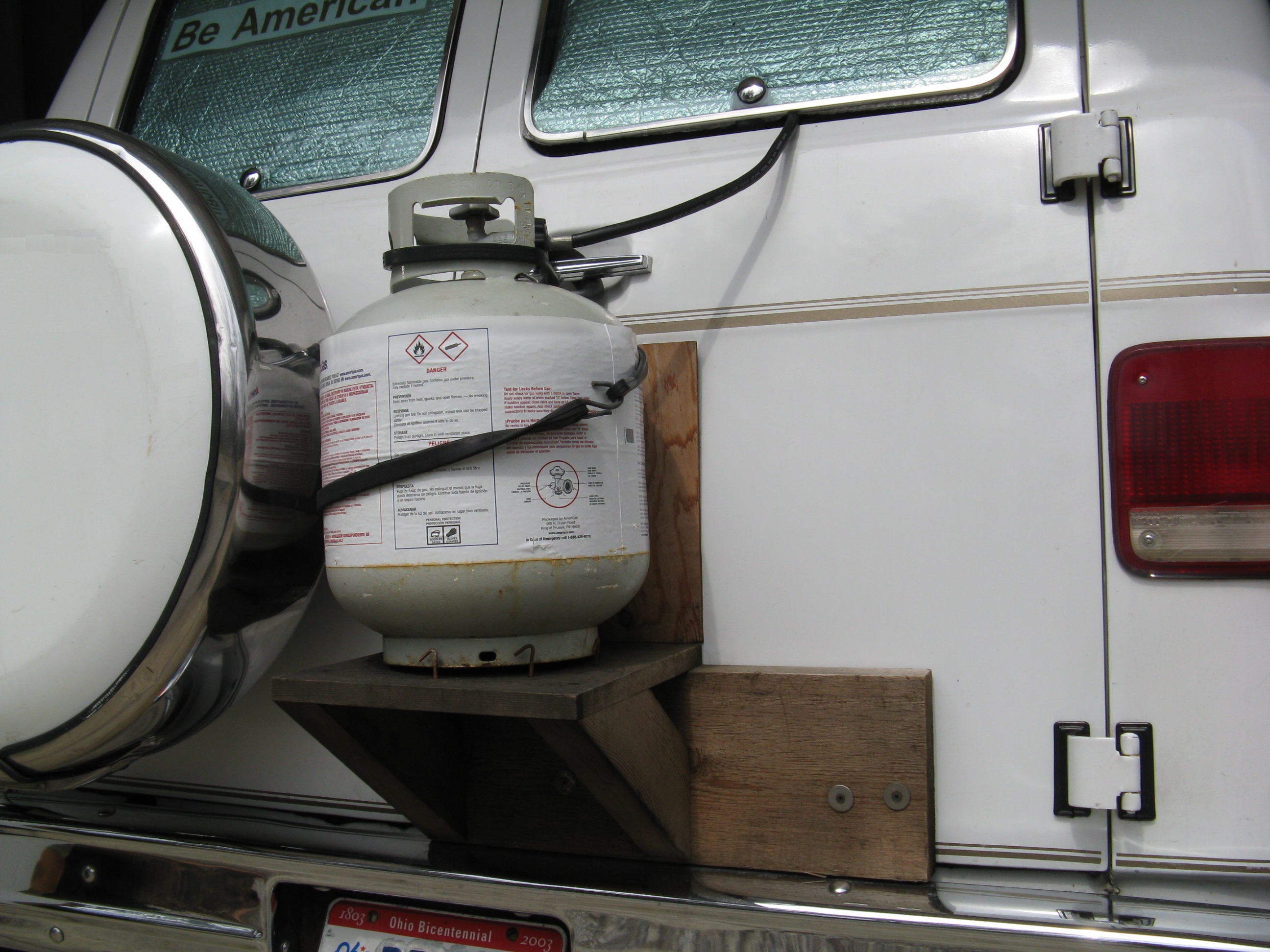
Be sure to read, understand, and follow all safety instructions and have some ventilation while using heaters. The venting is needed not only to prevent running out of oxygen but to also help keep dampness down, which can be a problem when it is extremely cold. If you notice the heater going out or is difficult to light, it is possible that there is a low amount of oxygen in the vehicle. You can prove that by taking the heater outside and trying to light it there. If low oxygen is the issue, open a door for a few minutes.
PLEASE BE EXTREMELY CAREFUL to prevent a blanket or anything else from falling onto the heater!!!
It is wise to have a Smoke Detector and Carbon Monoxide Detector hung from the ceiling.
WARNING! There was once a smell of smoke, after a corner of the blanket had dropped onto the heater, and both the Smoke Detector and Carbon Monoxide Detector failed to detect the smoke and fumes!
The "Lesson Learned" from that was to always wrap the edge of the blanket that is against the wall down under the bed mattress to prevent the possibility of any portion of the blanket from falling onto the heater, which should always be on the floor and away from the bed. -
Smoke and Carbon Monoxide Detector
This is hung from the ceiling.
WARNING! It has been shown that Smoke and Carbon Monoxide Detectors can fail to detect smoke and fumes! -
Jumper Cables
These are used to jump (i.e. charge) the vehicle battery, using another vehicle, and are placed under the bed.
These should never be needed to jump your battery unless your battery goes bad or you failed to only power your LED light(s) using the Portable Power Pack, which should always be charging while driving.
They may be used to assist others needing their battery jumped, but the Portable Power Pack proves to be most convenient for doing that.
These are placed in the dishpan reserved for changing engine oil that is placed under the bed that is securely held in place. -
Low Profile Tool Box with complete set of tools
This includes ratchets with sockets and extensions, wrenches, screw drivers, pliers, utility knife, hammer, etcetera.
This is placed under the bed that is securely held in place. -
Tire Pressure Gauge
This is used to ensure the spare tire and all others are always properly inflated all the time.
This is placed in the low profile drawer under the driver front seat. -
Spare Fuses and Light Bulbs
These are placed in the low profile drawer under the driver front seat.
-
12 VDC Air Compressor
These are very slow at inflating tires but may be needed in an emergency.
It is nearly impossible to inflate an air mattress with one.
This is placed in the dishpan reserved for changing engine oil that is placed under the bed that is securely held in place. -
12 VDC Air Mattress Inflator
These are very fast at inflating air mattresses and are also useful to blow dust and dirt out of hard to reach places when cleaning.
This is placed in the dishpan reserved for changing engine oil that is placed under the bed that is securely held in place. -
12 VDC Vacuum Cleaner
These are not very effective and the filter needs to be cleaned often.
This is one reason why Color Coordinated Rugs are used, which can be easily removed and cleaned.
This is placed in the dishpan reserved for changing engine oil that is placed under the bed that is securely held in place. -
Small Hand Broom
This is used to sweep any dust and dirt off the carpet protector.
This is placed in the dishpan reserved for changing engine oil that is placed under the bed that is securely held in place. -
12 VDC LED Light
This is hung above the bed and only used when necessary.
-
Portable Rechargeable LED Flashlight
This is for indoor and outdoor use and should always be charged.
-
GPS Receiver
This is used to be able to swiftly and reliably go wherever you want whenever you want and to reliably deal with detours.
GPS Receiver include a searching feature to swiftly locate the nearest library, fitness center, auto parts store, grocery store, or virtually any other place of interest.
This is also used when hiking. -
Citizens Band Radio
This is dialed to channel 19 to be able to swiftly learn about any traffic issues and to chat with other motorists.
Channel 9 is reserved for Emergencies.
Users typically have a "CB Handle" to identify themselves when talking on the CB Radio. The author's CB handle is "Skeptical". -
Small 12 VDC Portable TV/DVD
This is used to tune into weather and news and other entertainment.
-
CD/AM/FM/Weather/MP3 player
This is used to tune into weather and news and other entertainment.
-
Overalls, Hat, Gloves, Boots, and Raincoat
These are required to keep clean, warm, and dry while working on your vehicle, especially when it is brutally cold outside.
-
Detailed and Complete Repair Manual for YOUR Vehicle
This is required to perform virtually any repair required for your vehicle.
If any special tools are needed, the fine folks at many auto parts stores will loan tools to you.
Note that some identical items available at auto parts stores are also available at Walmart for much less.
For example, Valvoline Motor Oil at Advance Auto Parts costs approximately $28 but the exact same Valvoline Motor Oil sells for approximately $17 at Walmart.
That is a savings of $11 (28 - 17 = 11). -
On Board Diagnostics (ODB) II Scan Tool
This is used to read the vehicle computer self diagnostic codes to swiftly identify and repair vehicle malfunctions.
-
Multimeter
This is used to measure electrical voltage, resistance, and current.
-
Paper Towels, Windex, and Hand Cleaner
These are required to keep the windows, interior, and your hands clean.
Clean windows greatly improve your ability to drive safely and to enjoy the scenery. -
First Aid Kit
This is kept under the passenger front seat.
-
Long Sheathed Knife
This is for self defense and cutting food and always kept nearby.
-
Pepper Spray
This is for self defense and always kept nearby.
-
Fire Extinguisher
This is for extinguishing fires and for self defense.
It is placed for easy and swift access and must be held securely in place while driving. -
Hatchet
This is for cutting firewood and for self defense.
It is placed for easy and swift access and must be held securely in place while driving. -
Soft Brief Case or Laptop Computer Case
This is used to hold a small traveling case (for personal care and hygiene items) towel, and a change of clothes for after showering.
-
Little Black Book
This is absolutely positively a must and is used to record whenever the vehicle is fueled, when fluids or filters are changed, and when parts are replaced.
Each and every time the vehicle is fueled, fill the tank full and record the miles and gallons and then calculate the miles per gallon (i.e. miles / gallons = miles per gallon) since the previous fill up. Increased fuel consumption (i.e. decreased gas mileage) can be an indication that there are issues that need to be addressed such as engine ignition issues, clogged filters, improperly inflated tire(s), sticking brakes, leaking fuel line, failing sensors, and so forth.
Each and every time the vehicle has any fluids added or changed or parts changed, record the miles and date and then calculate how many miles and months since that operation was last performed. Increased fluid (e.g. engine oil) consumption is an indicator of worn parts (e.g. engine components).
Always keeping the vehicle "clean and well organized" (as visiting Police Officers stated about the author's van) is strongly recommended.
Notice that no firearms are mentioned for self-defense.
This is because it has been shown that one is more likely to kill or maim themselves or someone else by accident with
a firearm than by being mugged or robbed.
If a firearm is necessary, please follow the NRA rules at:
NRA Gun Safety Rules.
Please also review the "Lessons Learned" at the links listed below:
Gun Safety LESSONS LEARNED: Rule #1
Gun Safety LESSONS LEARNED: Rule #2
Gun Safety LESSONS LEARNED: Rule #3
Being mostly Vegan, canned vegetables and fruit and protein bars and such are all that are needed.
That is all stored in the low profile drawers placed under the bed that is securely held in place.
Fresh fruit and vegetables are stored in the cooler.
Whenever anything needs to be heated up, just peel the paper off the can and set it on top of the Portable Propane Heater for a few minutes.
After work, you are free to experience all the "New Adventures" you like.
The Driver's Lounge at Truck Stops (when one is in the area) can be nice to watch a movie at; especially now that no smoking is allowed.
Some other no (or low) cost activities are described at
No Cost Activities.
If you like, you can even make extra money removing trees (including the stumps and roots) that have been killed or blown over.
The large Ash tree, whose stump and roots are being pulled out below, fell victim to the Emerald Ash Borer as documented at
Emerald Ash Borer:

However, that will require that you purchase a large chain, chain saw, and shovel.

You may even haul it all to an EPA Certified Class II composting facility, but that will require that you purchase a trailer and possibly engine hoist as shown in the photo below:
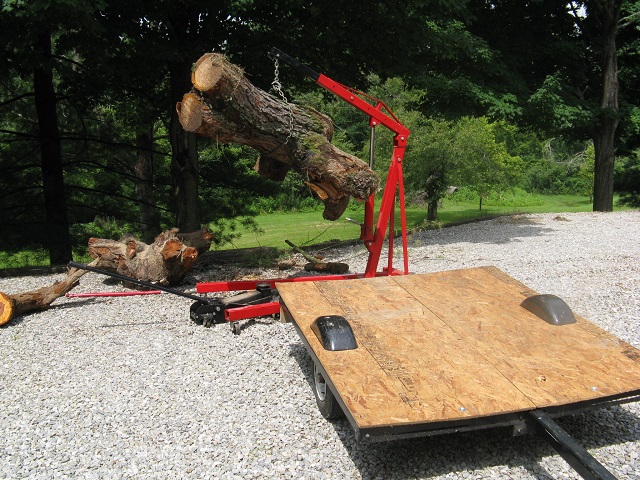
The large Pine tree, that is being taken to an EPA Certified Class II composting facility, fell victim to high straight-line winds of approximately 65 miles per hour:
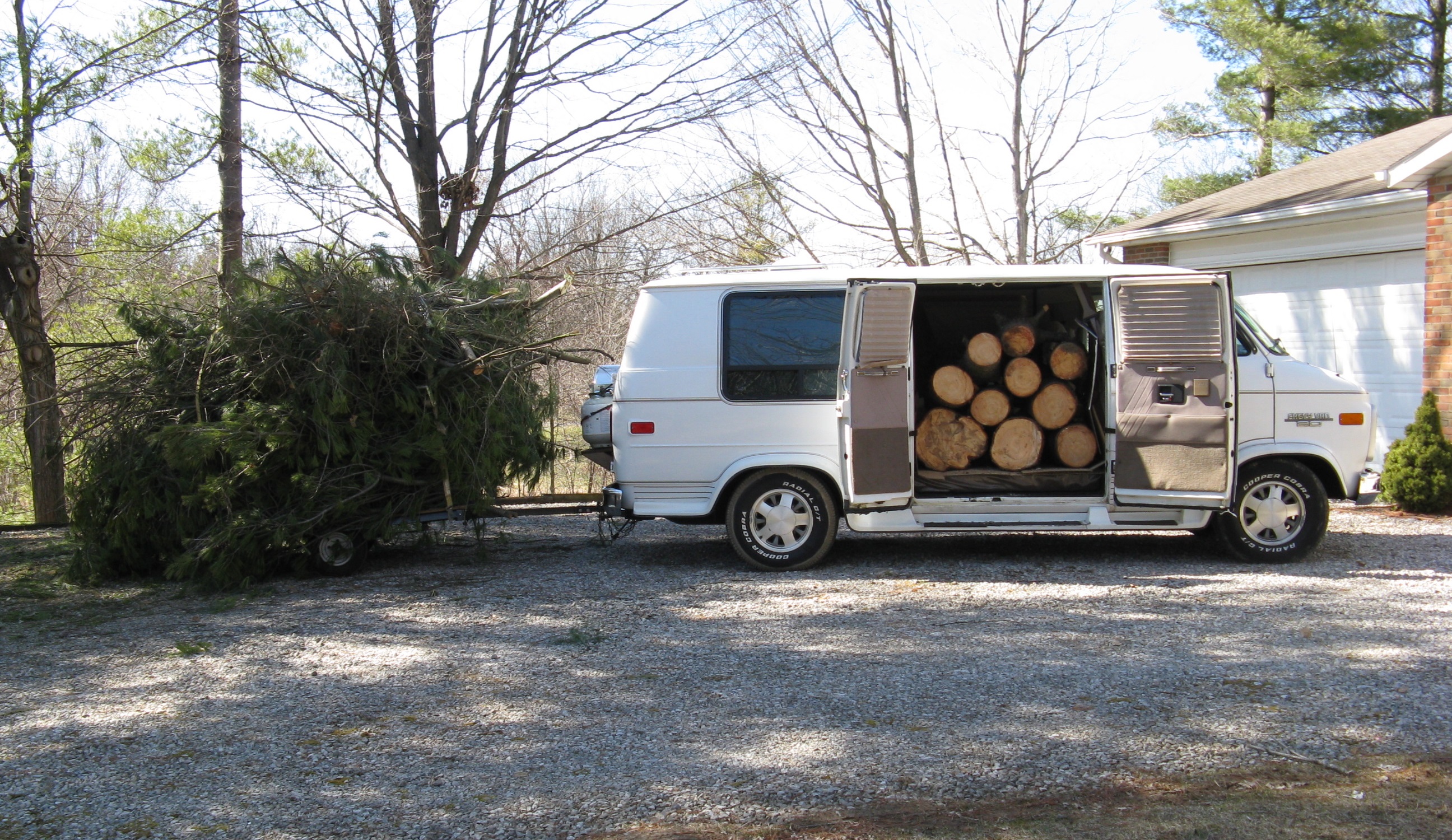
Note that the complete tree was taken away in a single trip utilizing the trailer and the inside of the van being protected with cardboard:
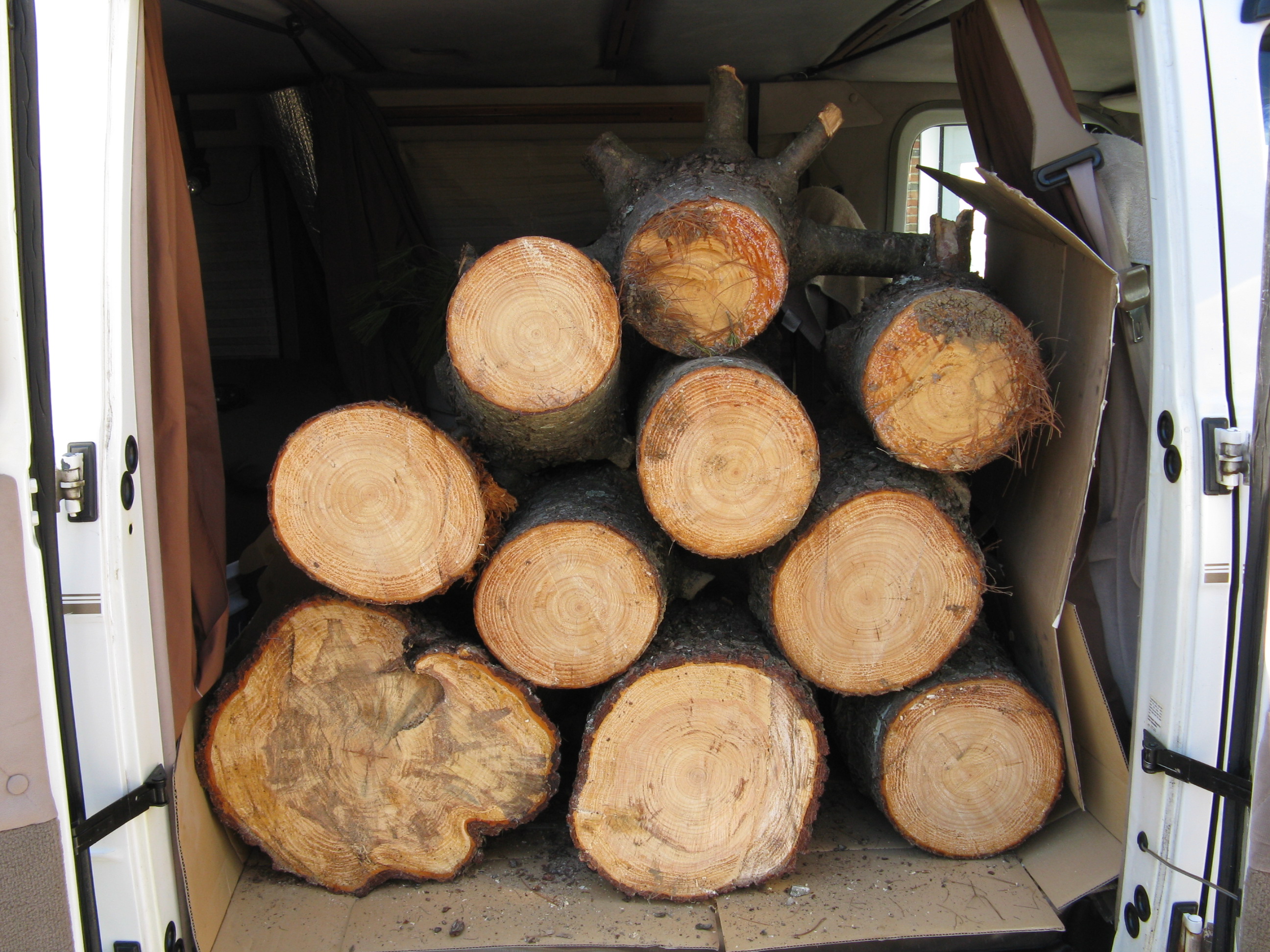
You may even consider becoming a "Motivational Speaker" as in the video at: "Living in a van down by the river"..
Convenient places to park and sleep include Truck Stops, 24 hour Shopping Centers (e.g. Walmart with the senior citizens),
Rest Areas, 24 hour Restaurants (e.g. McDonalds), Libraries, some Gas Stations with large parking lots, or at the beach.
It is best to park where it is well lit and also the least conspicuous.
It is wise to rotate where parked overnight to avoid drawing attention.
Examples follow:
Camp at Walmart with the (other) Senior Citizens:
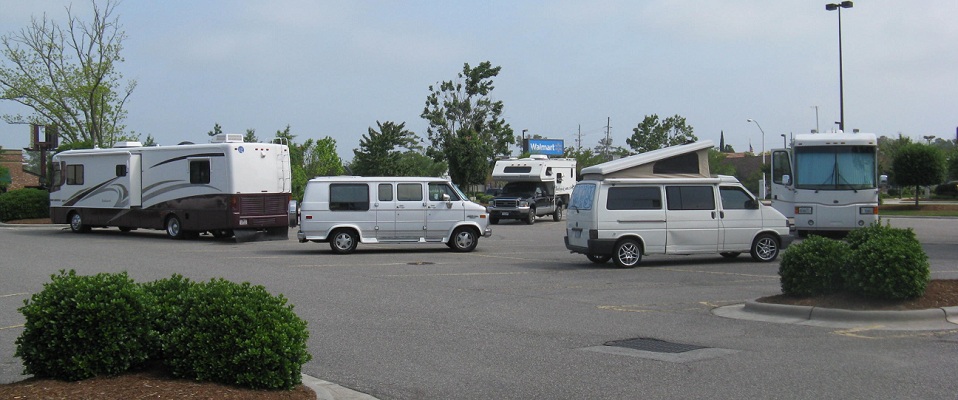
Park at the beach and sleep at or on that beach:
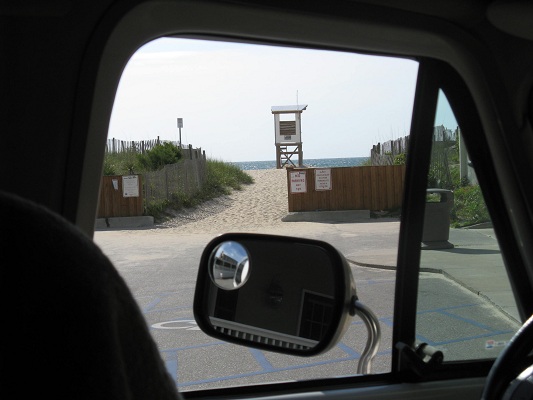
Obey all rules (i.e. Free Parking hours: 6:01pm - 8:59am)
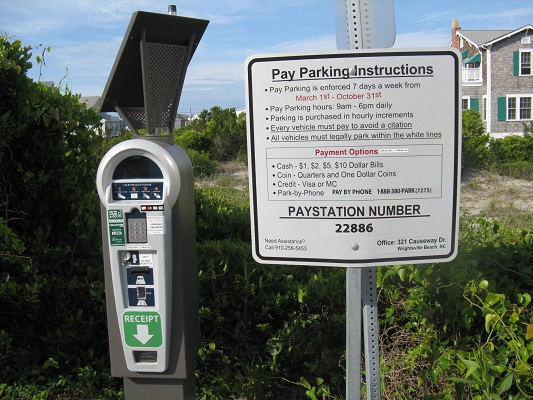
Park under a large shade tree:
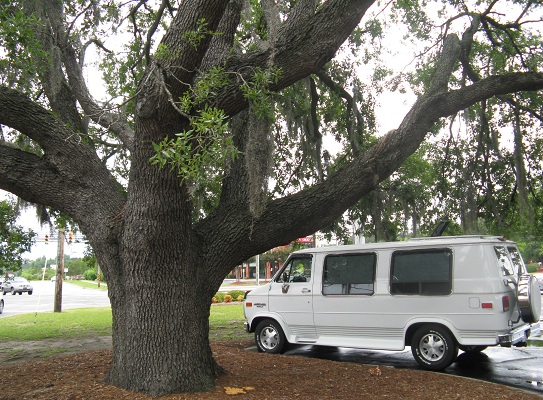
Permanently park for several months in the client's parking lot (and drive the car (e.g. Buick Regal) that you towed there):
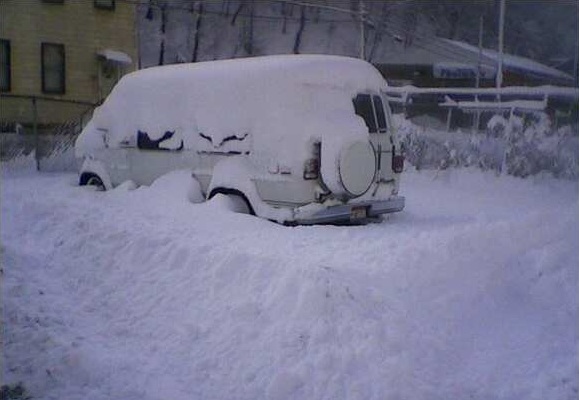
Keeping cool in hellishly hot and humid weather is probably the biggest challenge with "Low Cost Luxury Living". As discussed previously, keeping warm in temperatures down to freezing (i.e. 32 degrees) is possible by using the 1,500 BTU heater, and keeping warm in sub-zero temperatures (e.g. 11 degrees below zero so far) is possible by using the 4,000 BTU heater.
Obviously, parking in the shade will keep the vehicle cool.
However, when it is not possible to park the vehicle in the shade, park with the front of the vehicle
facing to the east and place reflective sun shades tightly against the windows.
The temperature of surfaces struck directly by the sun is considerably higher than when struck by
the sun at an angle.
For more information, see Sun Intensity vs. Angle.
When the vehicle is facing the east, the least amount of vehicle surface area is struck by the most
direct sunlight during the day.
That is, as the sun rises in the east, only the front of the vehicle is struck most directly by the sun.
And, as the sun sets in the west, only the rear of the vehicle is struck most directly by the sun.
A Vehicle Tent/Umbrella/Canopy such as that shown below can be considered but those are only rated to withstand approximately 30 mile per hour winds:
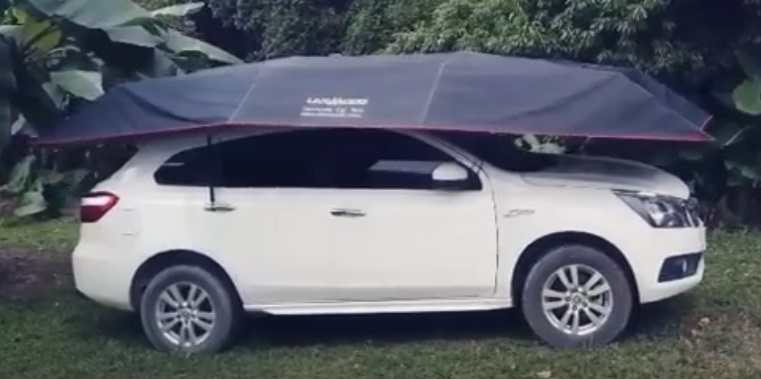
As discussed previously, a roof vent with fan is an absolute must.
Small side windows with screen allow cool air (without insects) to be pulled in as hot air is exhausted
out the roof vent.
Placing your feet in a pan of cool water while occasionally wiping water from the bottom of your
feet onto your legs helps to keep cool.
Placing cold or frozen bottles of water under your arms and sliding over your stomach and legs will quickly cool you off.
Wiping your body with a cloth or towel soaked in cold water is also effective.
Sleeping in a woven rope hammock, that permits air to circulate around your entire body, is one of
the most effective ways to keep cool.
To see where to mount a hammock, see WHERE TO MOUNT A HAMMOCK.
Having a hammock mounted inside your vehicle makes "Low Cost Luxury Living" cool, comfortable, and relaxing.
A woven rope hammock with spreader bars is recommended to allow air to circulate around your entire
body on hellishly hot and humid days and nights.
Each end of the hammock needs to have heavy duty hooks installed to allow the hammock to be quickly installed
and uninstalled.
Such a hammock is shown mounted inside the vehicle in the photo below.
Notice the easy access to the roof vent with fan, which also allows for easy and bug-free star-gazing.
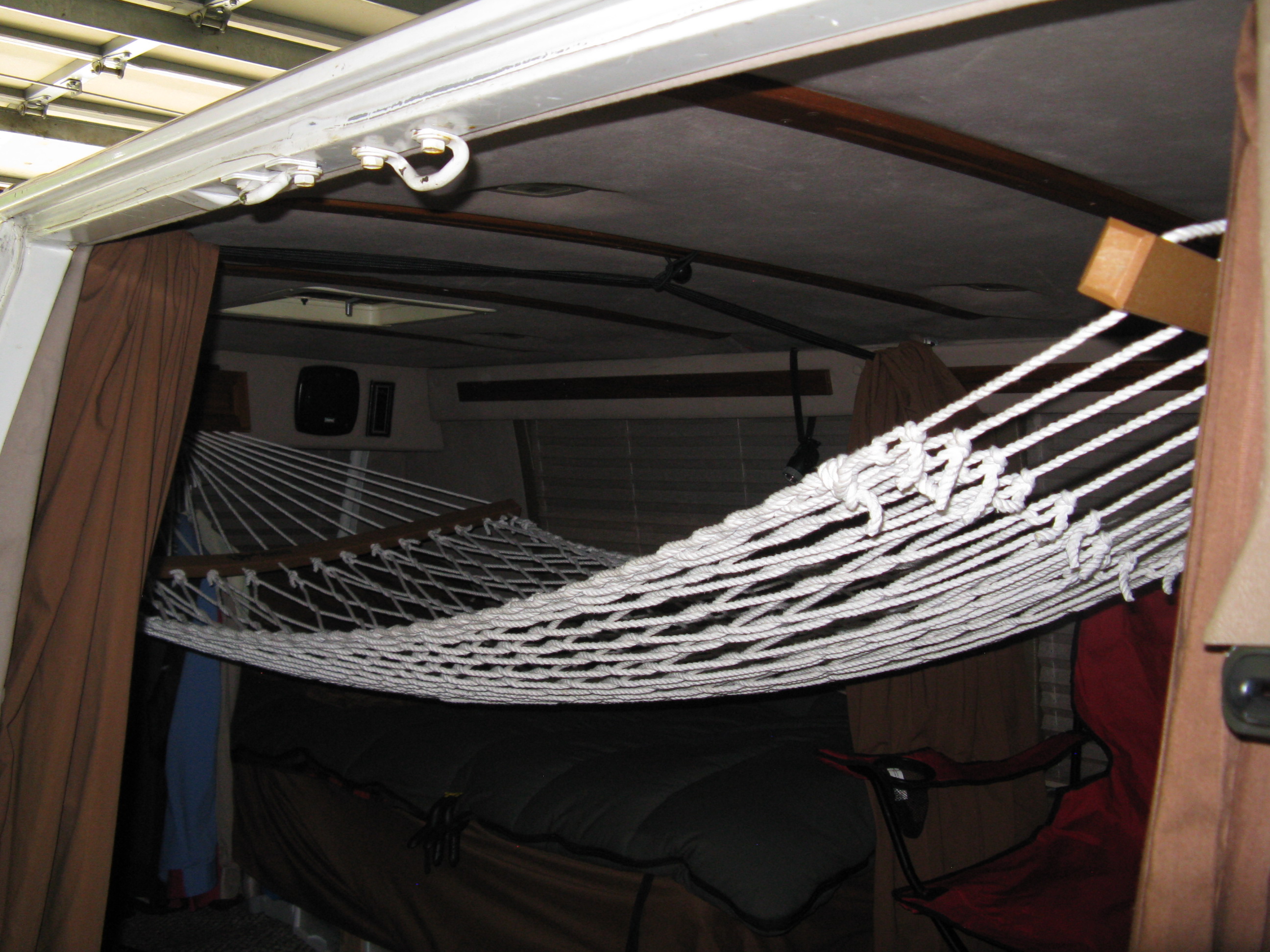
Each end of the hammock must be mounted to a sturdy location.
One location is produced by a chain that extends between and is bolted to the walls with the two
front seat belt shoulder harnesses as shown in the photo below.
Notice in this installation that the end of the hammock is wrapped over the chain, under the spreader bar,
and then hooked to the chain.
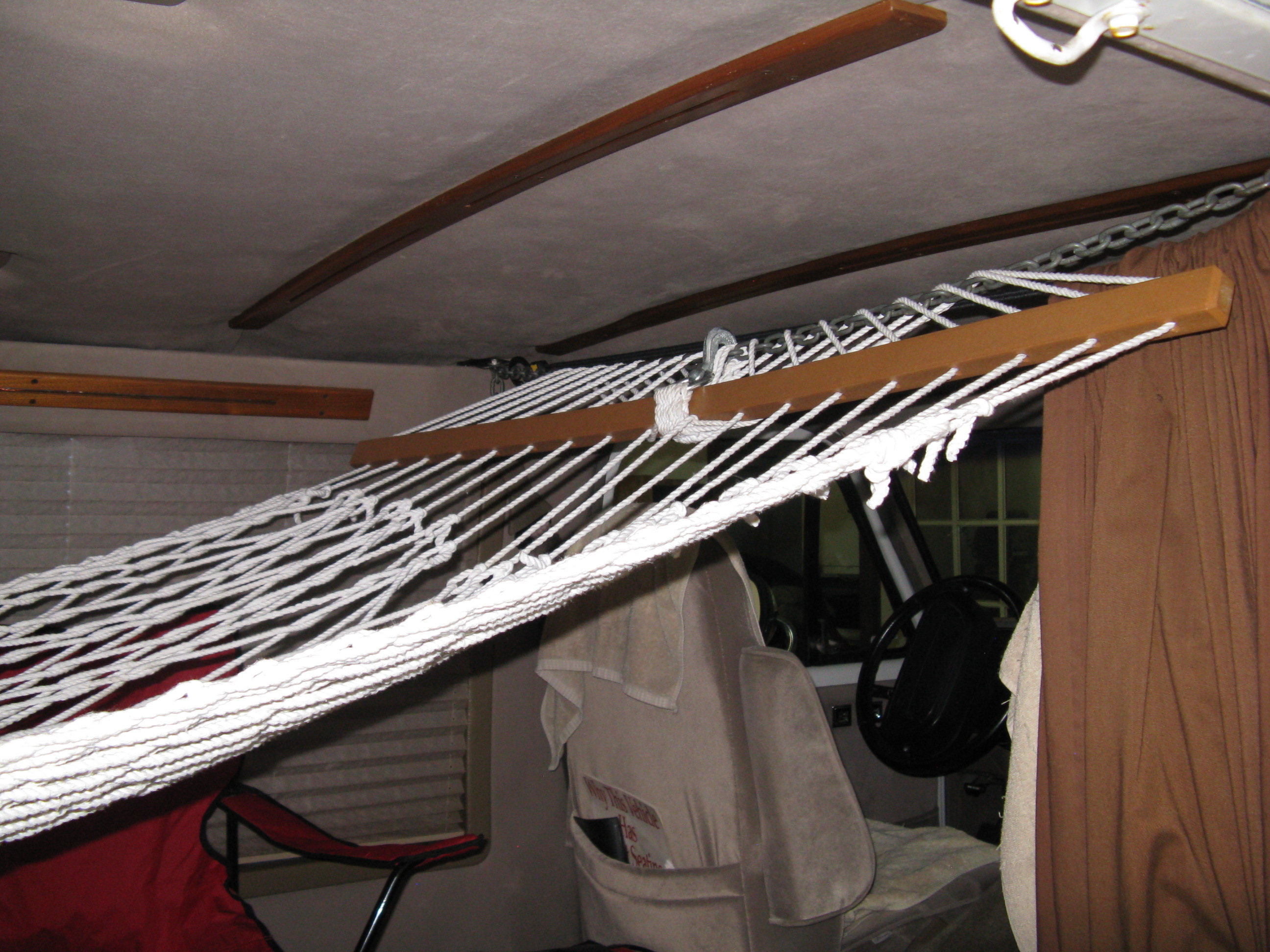
The photo below shows one end of the chain bolted to the wall with the passenger side seat belt shoulder harness.
The black bungee strap is used to hang the front privacy sheet from.
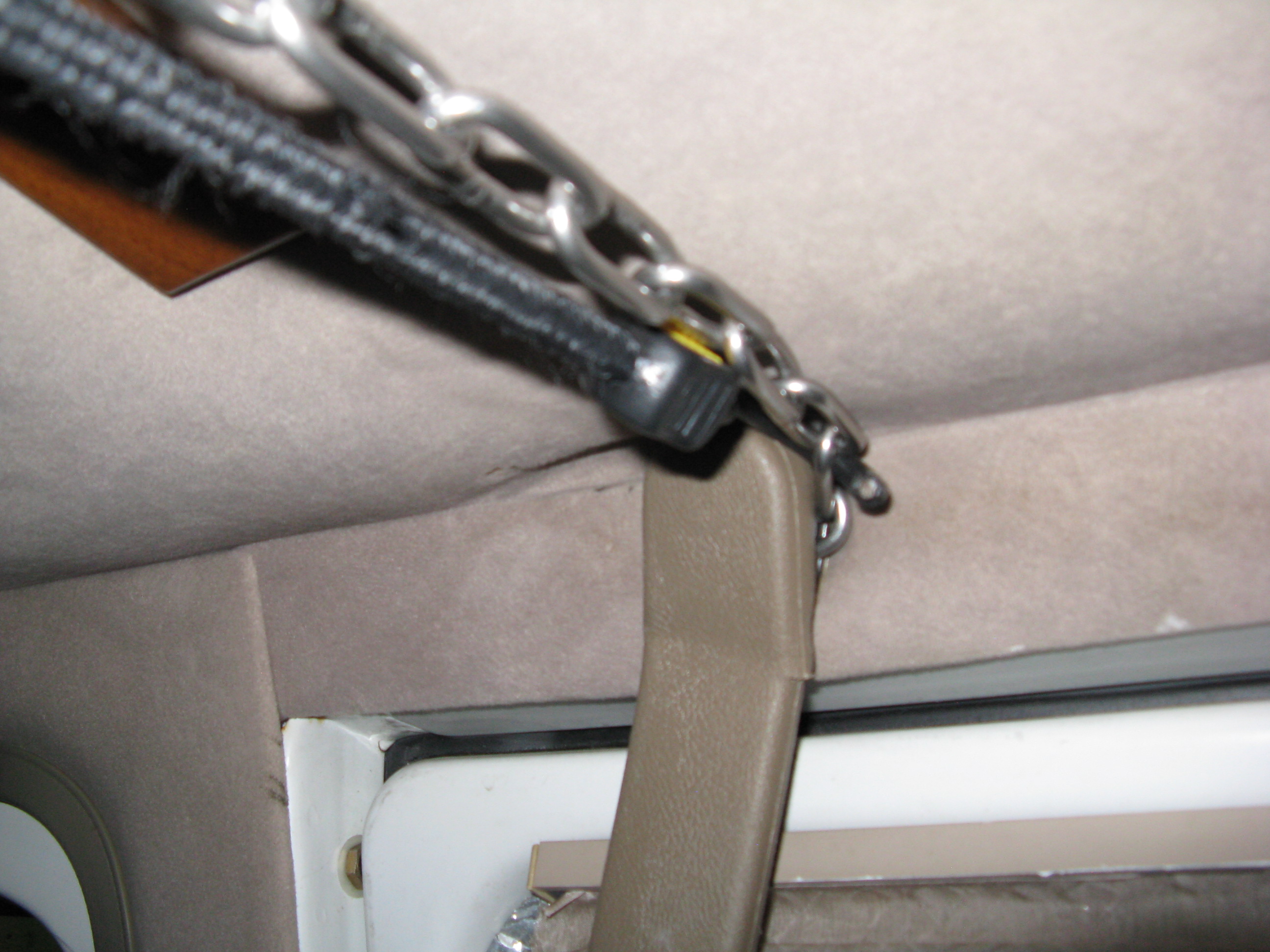
The photo below shows the other end of the chain bolted to a bracket that is bolted to the wall
with the driver side seat belt shoulder harness.
Notice the sturdy bracket required due to the window valance.
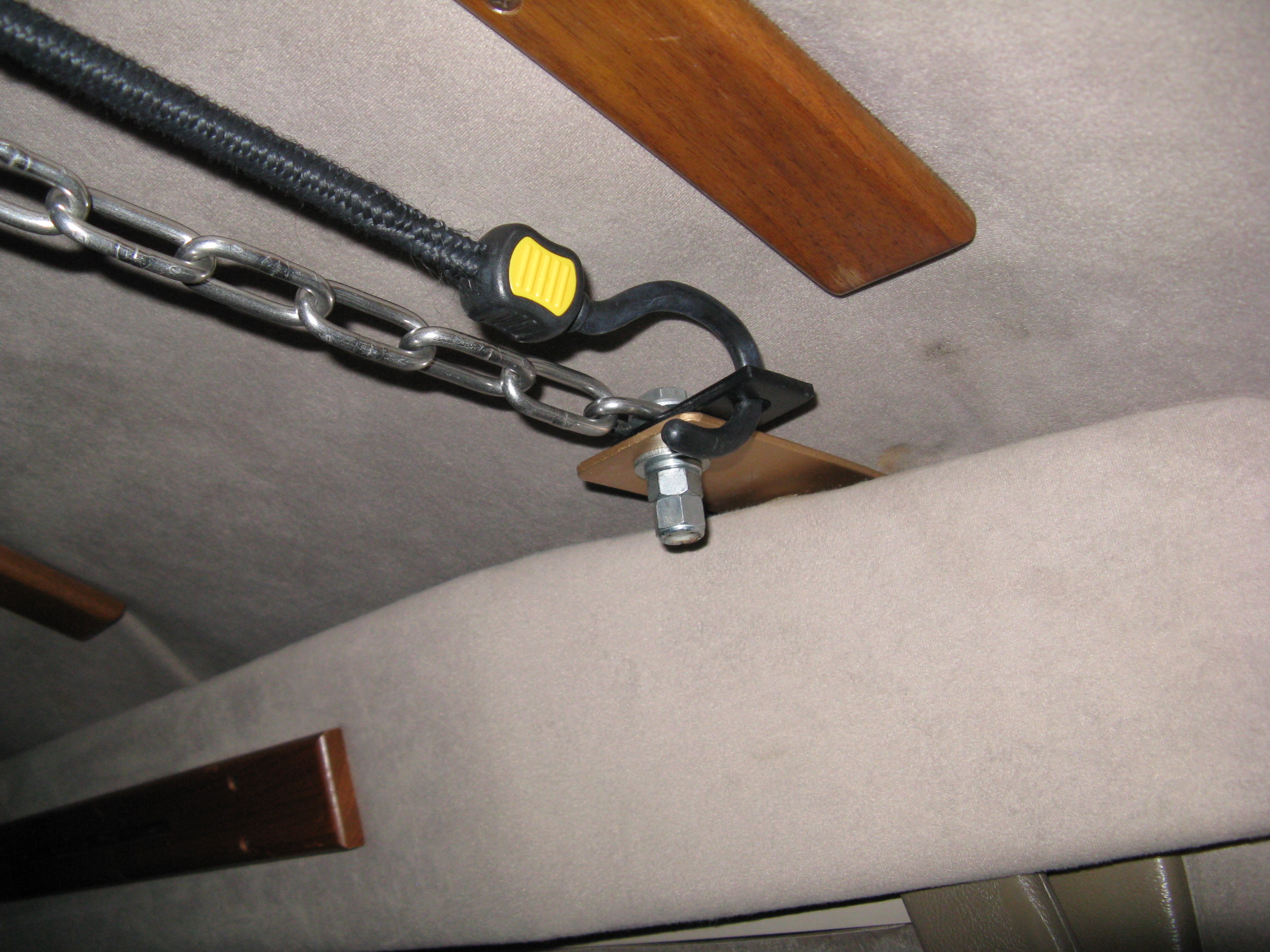
The other end of the hammock is hooked to a chain that has each end bolted to the roof edge with the
two rear door latch bracket bolts as shown in the photo below.
Notice that a hole needed to be drilled through the back of the small cabinet that is mounted above the two rear doors.
The split black plastic wire conduit wrapped around the edge of the hole protects that edge from the chain that
extends through the cabinet.
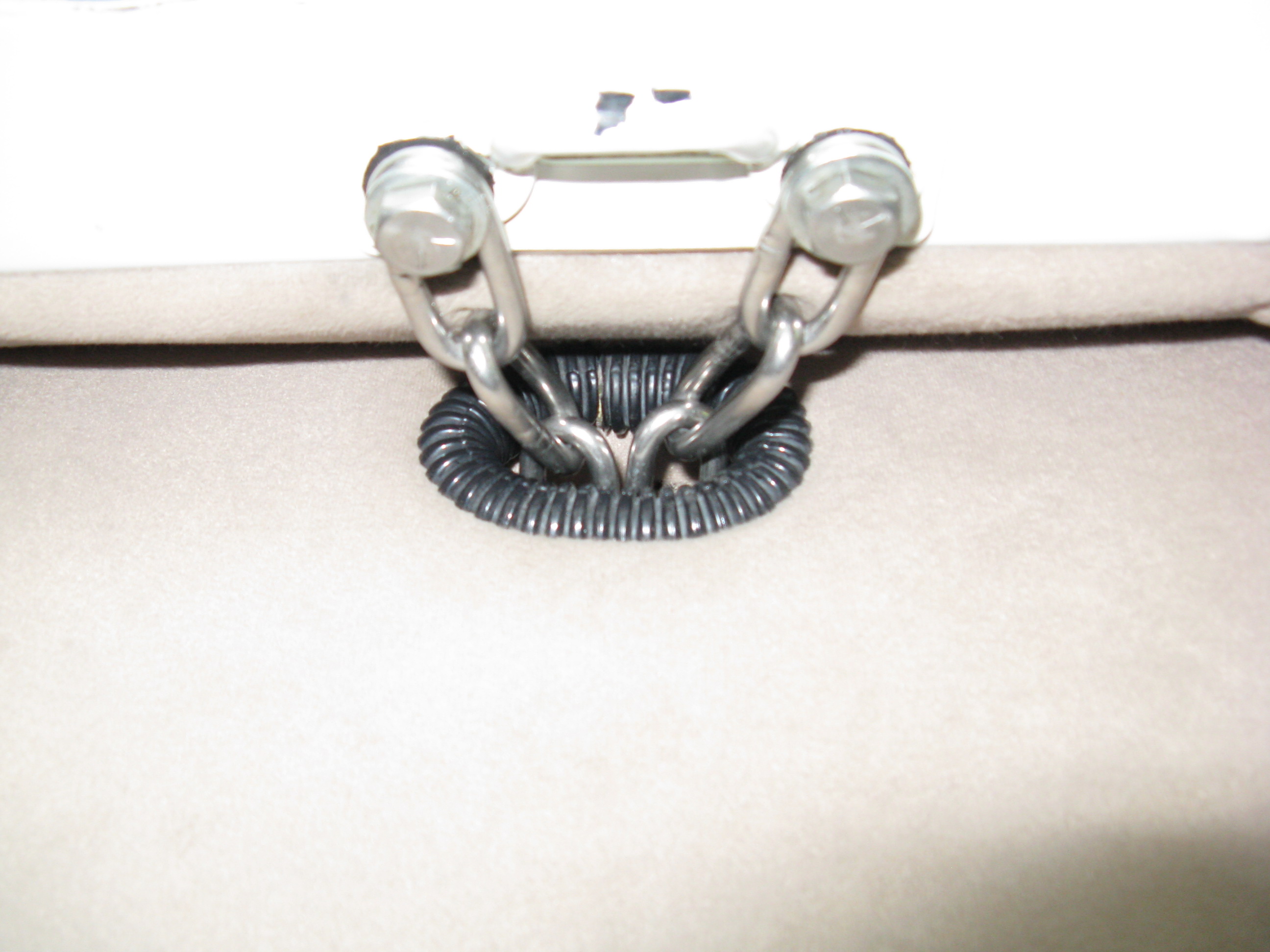
The photo below shows the other end of the hammock hooked to the chain that extends through the small cabinet
mounted above the two rear doors.
The thick split black styrofoam tube wrapped around the bottom edge of the cabinet is to protect that edge
from possible damage by the hammock rope.
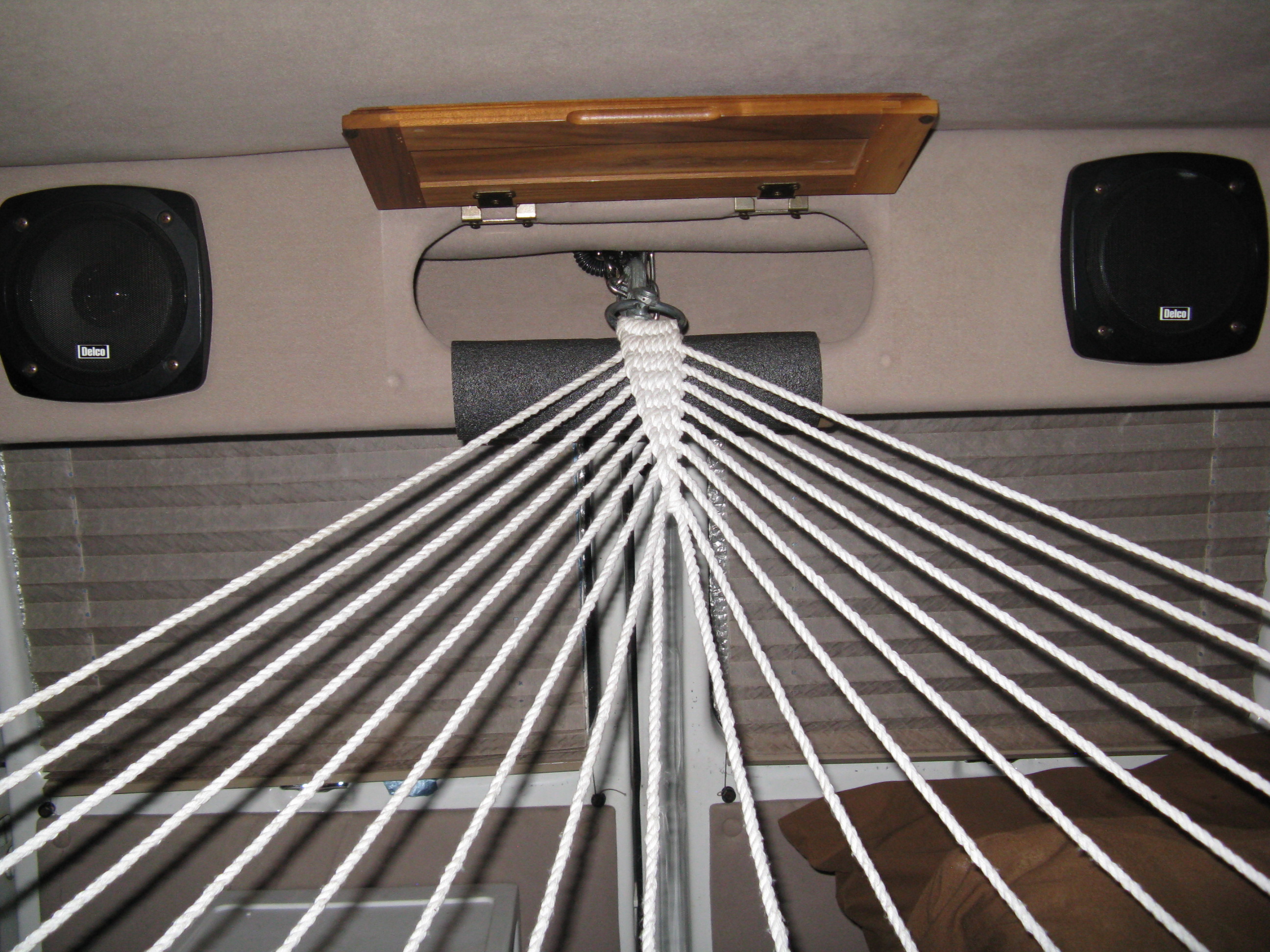
Showers can be taken at Truck Stops, Fitness Centers, and Community Centers, which can usually be located using the GPS Receiver.
Many companies have showers along with exercising facilities, which are quite nice.
Laundry is done at any conveniently located Laundromat, which can also be located using the GPS Receiver.
Washing the vehicle can be done at any conveniently located car wash.
Spencer (a Yorkshire TERROR) enjoys going to work and sleeping in the van.
All his toys and comforts from home are included.

Below is a photo of the author and Spencer.
Notice the harness and leash to keep Spencer safe and secure.

Below are photos of Spencer taking a walk in Wilmington, North Carolina on Wrightsville Beach, while working on a project for Corning Optical Fiber:

Below are photos of Spencer watching me while I work from my desk at Goodrich Power Systems in Twinsburg, Ohio.
Employees at the client company enjoy taking Spencer for walks during their break and bringing him carrots, his favorite treat.
Notice Spencer on the large soft blanket that covers the dashboard as well as the steering wheel to prevent Spencer
from possibly falling onto or into the steering wheel and being harmed.
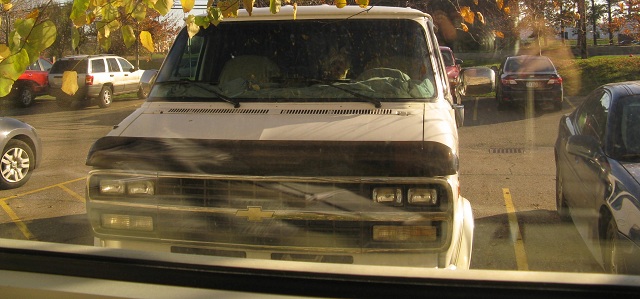
A closer look:
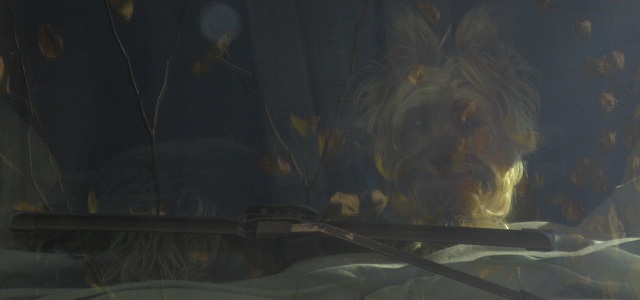
Below are photos of Spencer at Long Island Sound, New York watching the sun bathers and walking on the beach:
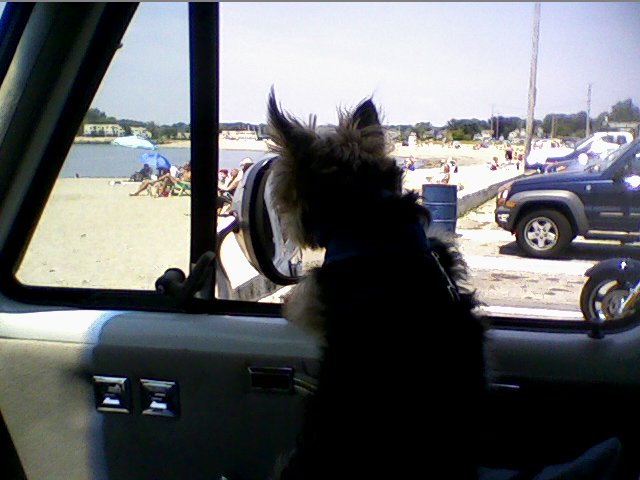

|
Low Cost Luxury Living is maximized by avoiding other high costs of living.
Health Care costs are very high and will continue to rise. Therefore, consuming healthy foods (e.g. being Vegan) and getting plenty of exercise (e.g. maintaining your vehicle) will contribute greatly to your health and happiness and to live a long life of low cost luxury.
Auto Care costs are also high. Performing your own repairs (and maintenance) will save you a great deal and provide you with an enormous amount of personal satisfaction and confidence in your ability to effectively and efficiently live a life of low cost luxury.
This is a possible project by the author: a Peterbilt 379EXHD Motorhome/Car Hauler:
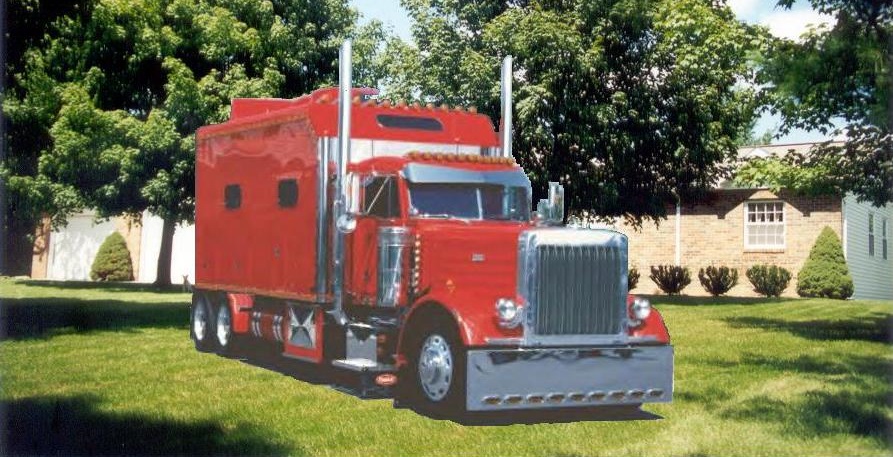
Do you see Spencer's pal Goliath in the photo above?
Other projects are presented at The Projects.
Other activities that Goliath and Spencer are featured in are available on the web site
SpareTimeActivities.net.
As the young lady states in her video below about those who live in their vehicles:
"We are self-sufficient, intelligent, and brave."